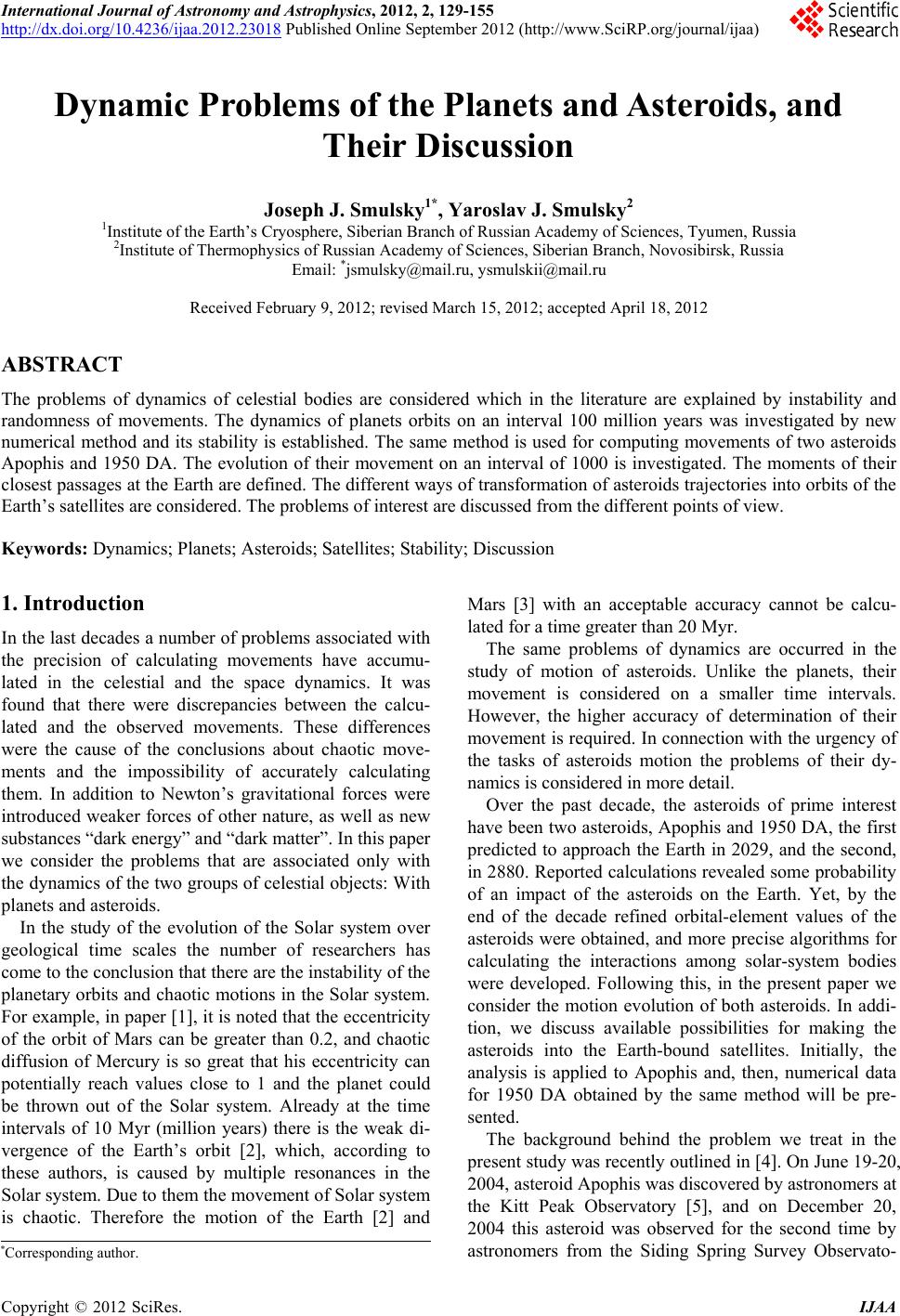 International Journal of Astronomy and Astrophysics, 2012, 2, 129-155 http://dx.doi.org/10.4236/ijaa.2012.23018 Published Online September 2012 (http://www.SciRP.org/journal/ijaa) Dynamic Problems of the Planets and Asteroids, and Their Discussion Joseph J. Smulsky1*, Yaroslav J. Smulsky2 1Institute of the Earth’s Cryosphere, Siberian Branch of Russian Academy of Sciences, Tyumen, Russia 2Institute of Thermophysics of Russian Academy of Sciences, Siberian Branch, Novosibirsk, Russia Email: *jsmulsky@mail.ru, ysmulskii@mail.ru Received February 9, 2012; revised March 15, 2012; accepted April 18, 2012 ABSTRACT The problems of dynamics of celestial bodies are considered which in the literature are explained by instability and randomness of movements. The dynamics of planets orbits on an interval 100 million years was investigated by new numerical method and its stability is established. The same method is used for computing movements of two asteroids Apophis and 1950 DA. The evolution of their movement on an interval of 1000 is investigated. The moments of their closest passages at the Earth are defined. The different ways of transformation of asteroids trajectories into orbits of the Earth’s satellites are considered. The problems of interest are discussed from the different points of view. Keywords: Dynamics; Planets; Asteroids; Satellites; Stability; Discussion 1. Introduction In the last decades a number of problems associated with the precision of calculating movements have accumu- lated in the celestial and the space dynamics. It was found that there were discrepancies between the calcu- lated and the observed movements. These differences were the cause of the conclusions about chaotic move- ments and the impossibility of accurately calculating them. In addition to Newton’s gravitational forces were introduced weaker forces of other nature, as well as new substances “dark energy” and “dark matter”. In this paper we consider the problems that are associated only with the dynamics of the two groups of celestial objects: With planets and asteroids. In the study of the evolution of the Solar system over geological time scales the number of researchers has come to the conclusion that there are the instability of the planetary orbits and chaotic motions in the Solar system. For example, in paper [1], it is noted that the eccentricity of the orbit of Mars can be greater than 0.2, and chaotic diffusion of Mercury is so great that his eccentricity can potentially reach values close to 1 and the planet could be thrown out of the Solar system. Already at the time intervals of 10 Myr (million years) there is the weak di- vergence of the Earth’s orbit [2], which, according to these authors, is caused by multiple resonances in the Solar system. Due to them the movement of Solar system is chaotic. Therefore the motion of the Earth [2] and Mars [3] with an acceptable accuracy cannot be calcu- lated for a time greater than 20 Myr. The same problems of dynamics are occurred in the study of motion of asteroids. Unlike the planets, their movement is considered on a smaller time intervals. However, the higher accuracy of determination of their movement is required. In connection with the urgency of the tasks of asteroids motion the problems of their dy- namics is considered in more detail. Over the past decade, the asteroids of prime interest have been two asteroids, Apophis and 1950 DA, the first predicted to approach the Earth in 2029, and the second, in 2880. Reported calculations revealed some probability of an impact of the asteroids on the Earth. Yet, by the end of the decade refined orbital-element values of the asteroids were obtained, and more precise algorithms for calculating the interactions among solar-system bodies were developed. Following this, in the present paper we consider the motion evolution of both asteroids. In addi- tion, we discuss available possibilities for making the asteroids into the Earth-bound satellites. Initially, the analysis is applied to Apophis and, then, numerical data for 1950 DA obtained by the same method will be pre- sented. The background behind the problem we treat in the present study was recently outlined in [4]. On June 19-20, 2004, asteroid Apophis was discovered by astronomers at the Kitt Peak Observatory [5], and on December 20, 2004 this asteroid was observed for the second time by astronomers from the Siding Spring Survey Observato- *Corresponding author. C opyright © 2012 SciRes. IJAA 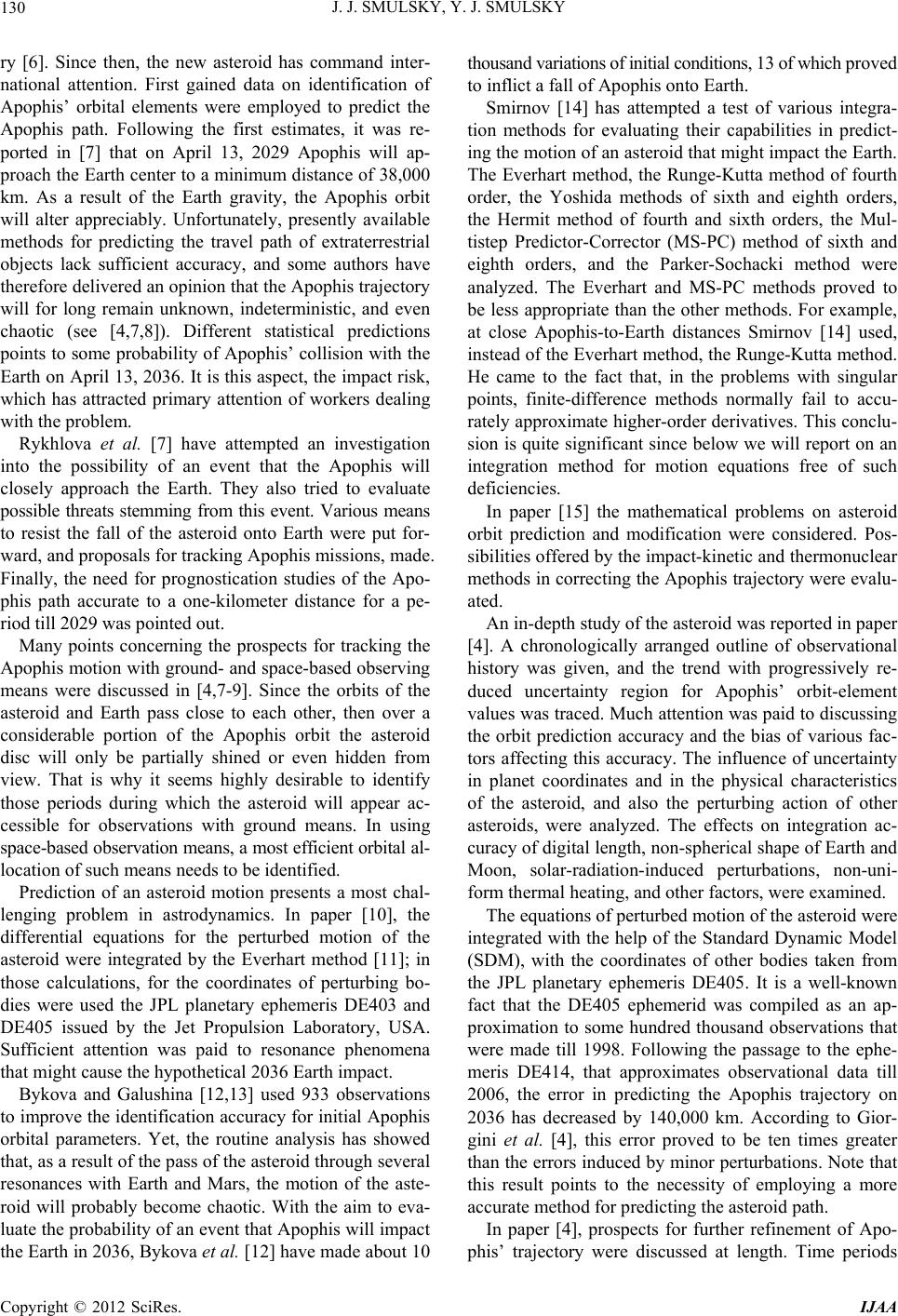 J. J. SMULSKY, Y. J. SMULSKY 130 ry [6]. Since then, the new asteroid has command inter- national attention. First gained data on identification of Apophis’ orbital elements were employed to predict the Apophis path. Following the first estimates, it was re- ported in [7] that on April 13, 2029 Apophis will ap- proach the Earth center to a minimum distance of 38,000 km. As a result of the Earth gravity, the Apophis orbit will alter appreciably. Unfortunately, presently available methods for predicting the travel path of extraterrestrial objects lack sufficient accuracy, and some authors have therefore delivered an opinion that the Apophis trajectory will for long remain unknown, indeterministic, and even chaotic (see [4,7,8]). Different statistical predictions points to some probability of Apophis’ collision with the Earth on April 13, 2036. It is this aspect, the impact risk, which has attracted primary attention of workers dealing with the problem. Rykhlova et al. [7] have attempted an investigation into the possibility of an event that the Apophis will closely approach the Earth. They also tried to evaluate possible threats stemming from this event. Various means to resist the fall of the asteroid onto Earth were put for- ward, and proposals for tracking Apophis missions, made. Finally, the need for prognostication studies of the Apo- phis path accurate to a one-kilometer distance for a pe- riod till 2029 was pointed out. Many points concerning the prospects for tracking the Apophis motion with ground- and space-based observing means were discussed in [4,7-9]. Since the orbits of the asteroid and Earth pass close to each other, then over a considerable portion of the Apophis orbit the asteroid disc will only be partially shined or even hidden from view. That is why it seems highly desirable to identify those periods during which the asteroid will appear ac- cessible for observations with ground means. In using space-based observation means, a most efficient orbital al- location of such means needs to be identified. Prediction of an asteroid motion presents a most chal- lenging problem in astrodynamics. In paper [10], the differential equations for the perturbed motion of the asteroid were integrated by the Everhart method [11]; in those calculations, for the coordinates of perturbing bo- dies were used the JPL planetary ephemeris DE403 and DE405 issued by the Jet Propulsion Laboratory, USA. Sufficient attention was paid to resonance phenomena that might cause the hypothetical 2036 Earth impact. Bykova and Galushina [12,13] used 933 observations to improve the identification accuracy for initial Apophis orbital parameters. Yet, the routine analysis has showed that, as a result of the pass of the asteroid through several resonances with Earth and Mars, the motion of the aste- roid will probably become chaotic. With the aim to eva- luate the probability of an event that Apophis will impact the Earth in 2036, Bykova et al. [12] have made about 10 thousand variations of initial conditions, 13 of which proved to inflict a fall of Apophis onto Earth. Smirnov [14] has attempted a test of various integra- tion methods for evaluating their capabilities in predict- ing the motion of an asteroid that might impact the Earth. The Everhart method, the Runge-Kutta method of fourth order, the Yoshida methods of sixth and eighth orders, the Hermit method of fourth and sixth orders, the Mul- tistep Predictor-Corrector (MS-PC) method of sixth and eighth orders, and the Parker-Sochacki method were analyzed. The Everhart and MS-PC methods proved to be less appropriate than the other methods. For example, at close Apophis-to-Earth distances Smirnov [14] used, instead of the Everhart method, the Runge-Kutta method. He came to the fact that, in the problems with singular points, finite-difference methods normally fail to accu- rately approximate higher-order derivatives. This conclu- sion is quite significant since below we will report on an integration method for motion equations free of such deficiencies. In paper [15] the mathematical problems on asteroid orbit prediction and modification were considered. Pos- sibilities offered by the impact-kinetic and thermonuclear methods in correcting the Apophis trajectory were evalu- ated. An in-depth study of the asteroid was reported in paper [4]. A chronologically arranged outline of observational history was given, and the trend with progressively re- duced uncertainty region for Apophis’ orbit-element values was traced. Much attention was paid to discussing the orbit prediction accuracy and the bias of various fac- tors affecting this accuracy. The influence of uncertainty in planet coordinates and in the physical characteristics of the asteroid, and also the perturbing action of other asteroids, were analyzed. The effects on integration ac- curacy of digital length, non-spherical shape of Earth and Moon, solar-radiation-induced perturbations, non-uni- form thermal heating, and other factors, were examined. The equations of perturbed motion of the asteroid were integrated with the help of the Standard Dynamic Model (SDM), with the coordinates of other bodies taken from the JPL planetary ephemeris DE405. It is a well-known fact that the DE405 ephemerid was compiled as an ap- proximation to some hundred thousand observations that were made till 1998. Following the passage to the ephe- meris DE414, that approximates observational data till 2006, the error in predicting the Apophis trajectory on 2036 has decreased by 140,000 km. According to Gior- gini et al. [4], this error proved to be ten times greater than the errors induced by minor perturbations. Note that this result points to the necessity of employing a more accurate method for predicting the asteroid path. In paper [4], prospects for further refinement of Apo- phis’ trajectory were discussed at length. Time periods Copyright © 2012 SciRes. IJAA 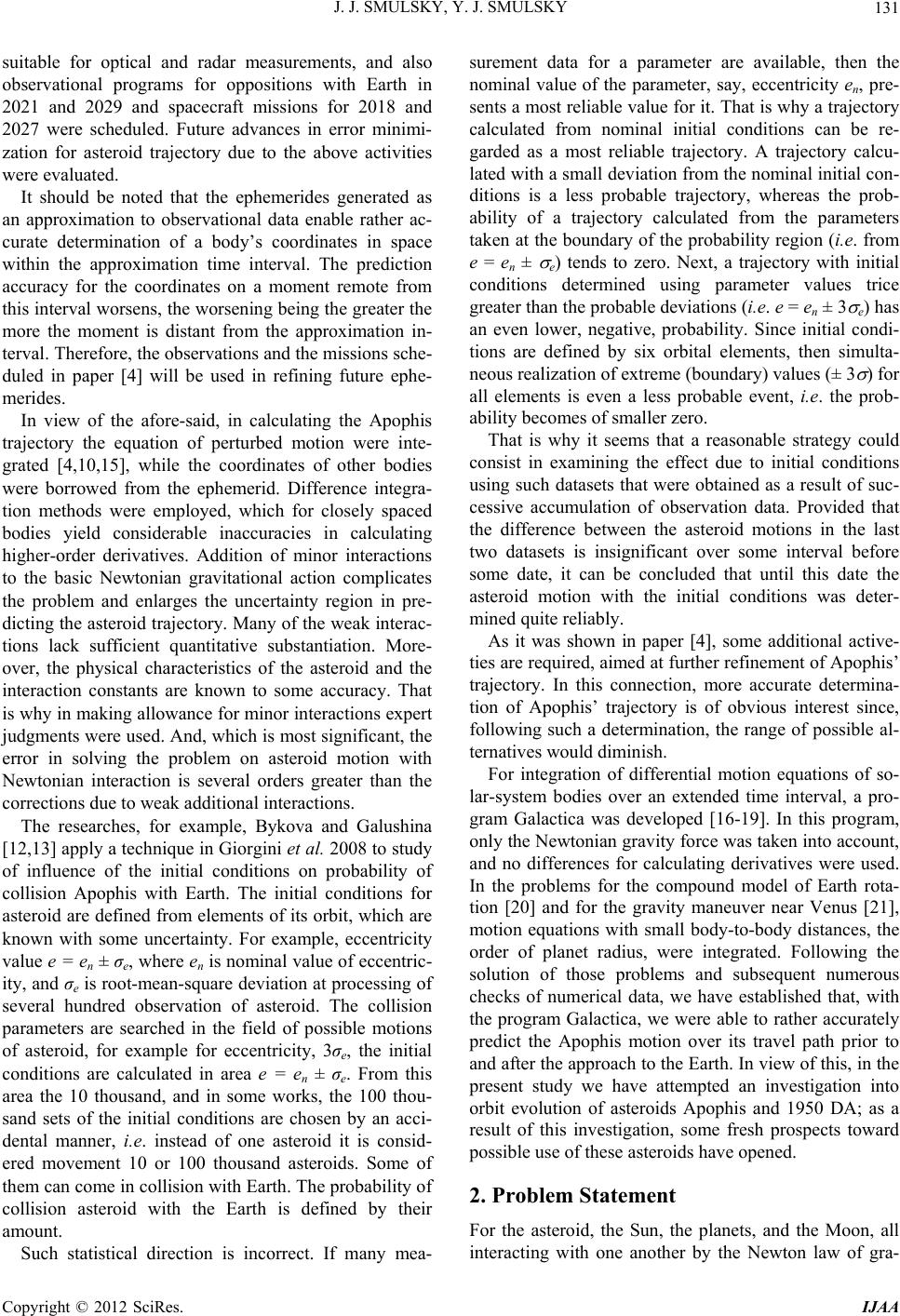 J. J. SMULSKY, Y. J. SMULSKY 131 suitable for optical and radar measurements, and also observational programs for oppositions with Earth in 2021 and 2029 and spacecraft missions for 2018 and 2027 were scheduled. Future advances in error minimi- zation for asteroid trajectory due to the above activities were evaluated. It should be noted that the ephemerides generated as an approximation to observational data enable rather ac- curate determination of a body’s coordinates in space within the approximation time interval. The prediction accuracy for the coordinates on a moment remote from this interval worsens, the worsening being the greater the more the moment is distant from the approximation in- terval. Therefore, the observations and the missions sche- duled in paper [4] will be used in refining future ephe- merides. In view of the afore-said, in calculating the Apophis trajectory the equation of perturbed motion were inte- grated [4,10,15], while the coordinates of other bodies were borrowed from the ephemerid. Difference integra- tion methods were employed, which for closely spaced bodies yield considerable inaccuracies in calculating higher-order derivatives. Addition of minor interactions to the basic Newtonian gravitational action complicates the problem and enlarges the uncertainty region in pre- dicting the asteroid trajectory. Many of the weak interac- tions lack sufficient quantitative substantiation. More- over, the physical characteristics of the asteroid and the interaction constants are known to some accuracy. That is why in making allowance for minor interactions expert judgments were used. And, which is most significant, the error in solving the problem on asteroid motion with Newtonian interaction is several orders greater than the corrections due to weak additional interactions. The researches, for example, Bykova and Galushina [12,13] apply a technique in Giorgini et al. 2008 to study of influence of the initial conditions on probability of collision Apophis with Earth. The initial conditions for asteroid are defined from elements of its orbit, which are known with some uncertainty. For example, eccentricity value e = en ± σe, where en is nominal value of eccentric- ity, and σe is root-mean-square deviation at processing of several hundred observation of asteroid. The collision parameters are searched in the field of possible motions of asteroid, for example for eccentricity, 3σe, the initial conditions are calculated in area e = en ± σe. From this area the 10 thousand, and in some works, the 100 thou- sand sets of the initial conditions are chosen by an acci- dental manner, i.e. instead of one asteroid it is consid- ered movement 10 or 100 thousand asteroids. Some of them can come in collision with Earth. The probability of collision asteroid with the Earth is defined by their amount. Such statistical direction is incorrect. If many mea- surement data for a parameter are available, then the nominal value of the parameter, say, eccentricity en, pre- sents a most reliable value for it. That is why a trajectory calculated from nominal initial conditions can be re- garded as a most reliable trajectory. A trajectory calcu- lated with a small deviation from the nominal initial con- ditions is a less probable trajectory, whereas the prob- ability of a trajectory calculated from the parameters taken at the boundary of the probability region (i.e. from e = en ± e) tends to zero. Next, a trajectory with initial conditions determined using parameter values trice greater than the probable deviations (i.e. e = en ± 3 e) has an even lower, negative, probability. Since initial condi- tions are defined by six orbital elements, then simulta- neous realization of extreme (boundary) values (± 3 ) for all elements is even a less probable event, i.e. the prob- ability becomes of smaller zero. That is why it seems that a reasonable strategy could consist in examining the effect due to initial conditions using such datasets that were obtained as a result of suc- cessive accumulation of observation data. Provided that the difference between the asteroid motions in the last two datasets is insignificant over some interval before some date, it can be concluded that until this date the asteroid motion with the initial conditions was deter- mined quite reliably. As it was shown in paper [4], some additional active- ties are required, aimed at further refinement of Apophis’ trajectory. In this connection, more accurate determina- tion of Apophis’ trajectory is of obvious interest since, following such a determination, the range of possible al- ternatives would diminish. For integration of differential motion equations of so- lar-system bodies over an extended time interval, a pro- gram Galactica was developed [16-19]. In this program, only the Newtonian gravity force was taken into account, and no differences for calculating derivatives were used. In the problems for the compound model of Earth rota- tion [20] and for the gravity maneuver near Venus [21], motion equations with small body-to-body distances, the order of planet radius, were integrated. Following the solution of those problems and subsequent numerous checks of numerical data, we have established that, with the program Galactica, we were able to rather accurately predict the Apophis motion over its travel path prior to and after the approach to the Earth. In view of this, in the present study we have attempted an investigation into orbit evolution of asteroids Apophis and 1950 DA; as a result of this investigation, some fresh prospects toward possible use of these asteroids have opened. 2. Problem Statement For the asteroid, the Sun, the planets, and the Moon, all interacting with one another by the Newton law of gra- Copyright © 2012 SciRes. IJAA  J. J. SMULSKY, Y. J. SMULSKY 132 vity, the differential motion equations have the form [16]: 2 23 d, 1,2,, d n ikik ki ik m Gi tr rr n (1) where i is radius-vector of a body with mass i rela- tively Solar System barycenter; G is gravitational con- stant; is vector and rik is its module; n = 12. r r m ik ik As a result of numerical experiments and their analysis we came to a conclusion, that finite-difference methods of integration do not provide necessary accuracy. For the integration of Equation (1) we have developed algorithm and program Galactica. The meaning of function at the following moment of time t = t0 + t is determined with the help of Taylor series, which, for example, for coor- dinate x looks like: rr 00 1 1 ! Kk k k xx k t (2) where 0 k is derivative of k order at the initial moment t0. The meaning of velocity is defined by the similar formula, and acceleration 0 by the Equation (1). Higher derivatives 0 k we are determined analytically as a result of differentiation of the Equation (1). The cal- culation algorithm of the sixth order is now used, i.e. with K = 6. A few words about the method used and the program Galactica. The algorithms of finite-difference methods are derived from the Taylor series (2). In this case the higher derivatives are determined by the difference of the second derivatives at different steps. This leads to errors of integration. There are methods [22,23], in which the derivatives are determined by recurrence formulas. In the program Galactica the derivatives are calculated under the exact analytical formulas, which we have deduced. This provides greater accuracy than other methods. Besides in the program Galactica there are many other details, which allow to not reducing the achieved in such way accuracy. They were found in the process of creat- ing the program Galactica. During its development more than 10 different ways to control errors has been used. In our book [19] the following checks are made mention of: 1) Checking the stability of the angular momentum M of the Solar System; 2) Checking the magnitude of the momentum Р of the Solar System; 4) Integrating backwards and forwards in time; 5) Integrating into a remote epoch and subsequent re- turn to the initial epoch; 6) Picking persistent changes (orbital major semiaxis, period, or precession axis etc.) and their checking; 7) Checking against test problems with exact analytic- cal solutions, for example, n-axisymmetrical problem [24]; 8) Comparison with observations; 9) Comparison with other reported data. The high accuracy of the program Galactica is firstly allowed to integrate Equations (1) for the motion of the Solar System for 100 million years [19]. The error was less on some orders in comparison with work [25], in which this problem has been solved for 3 million years by Stórmer method. The program Galactica allows solving the problem of interaction of any number of bodies, which motion is described by Equations (1). For example, the problem of the evolution of Earth’s rotation axis [20] was solved. In this task, the rotational motion of the Earth’s has been replaced by a compound model of the Earth’s rotation. The compound model of the Sun’s rotation was used in another task [26], in which the influence of the oblate rotating Sun on the motion of planets was established. In all these problems, this method of integration and pro- gram Galactica had no failures and we successfully used them. As noted above, the methods, which use Standard Dy- namic Model, are approximation of the data of Solar Sys- tem body’s observations. To calculate the future move- ment of the asteroid the bodies’ positions are used out- side the framework of observation. Therefore the calcu- lation error increases with distance in time from the base of observations. The base of observations is not used in program Galactica, so this error is missing in it. A high accuracy of the integration method of Galactica allows for a smaller error compute motion of asteroids in their rapprochement with the celestial bodies. The free-access Galactica system, user version for per- sonal computer, can be found at: http://www.ikz.ru/~smulski/GalactcW. The system of Ga- lactica, except the program Galactica, includes several components, which are described in the User’s Guide htt p://www.ikz.ru/~smulsk i/GalactcW /GalD i s cr E . pd f . The Guide also provides detailed instructions for all stages of solving the problem. After the free-access system is created based on a supercomputer, we will post the in- formation at the above site. 3. The Dynamics of the Planets’ Orbits To study the dynamics of the Solar system we used the initial conditions (IC) on the 30.12.1949 with the Julian day JD0 = 2433280.5 in two versions. The first version of the IC was based on ephemerid DE19 of Jet Propulsion Laboratory, USA (JPL), a second version is based on the ephemerid DE406. The first IC was in a coordinate sys- tem of 1950.0, while the second—in the system of 2000.0. These initial conditions are given in our paper [19] and on the website http://www.ikz.ru/~smulski/Data/ OrbtData. As already mentioned, the differential Equa- Copyright © 2012 SciRes. IJAA 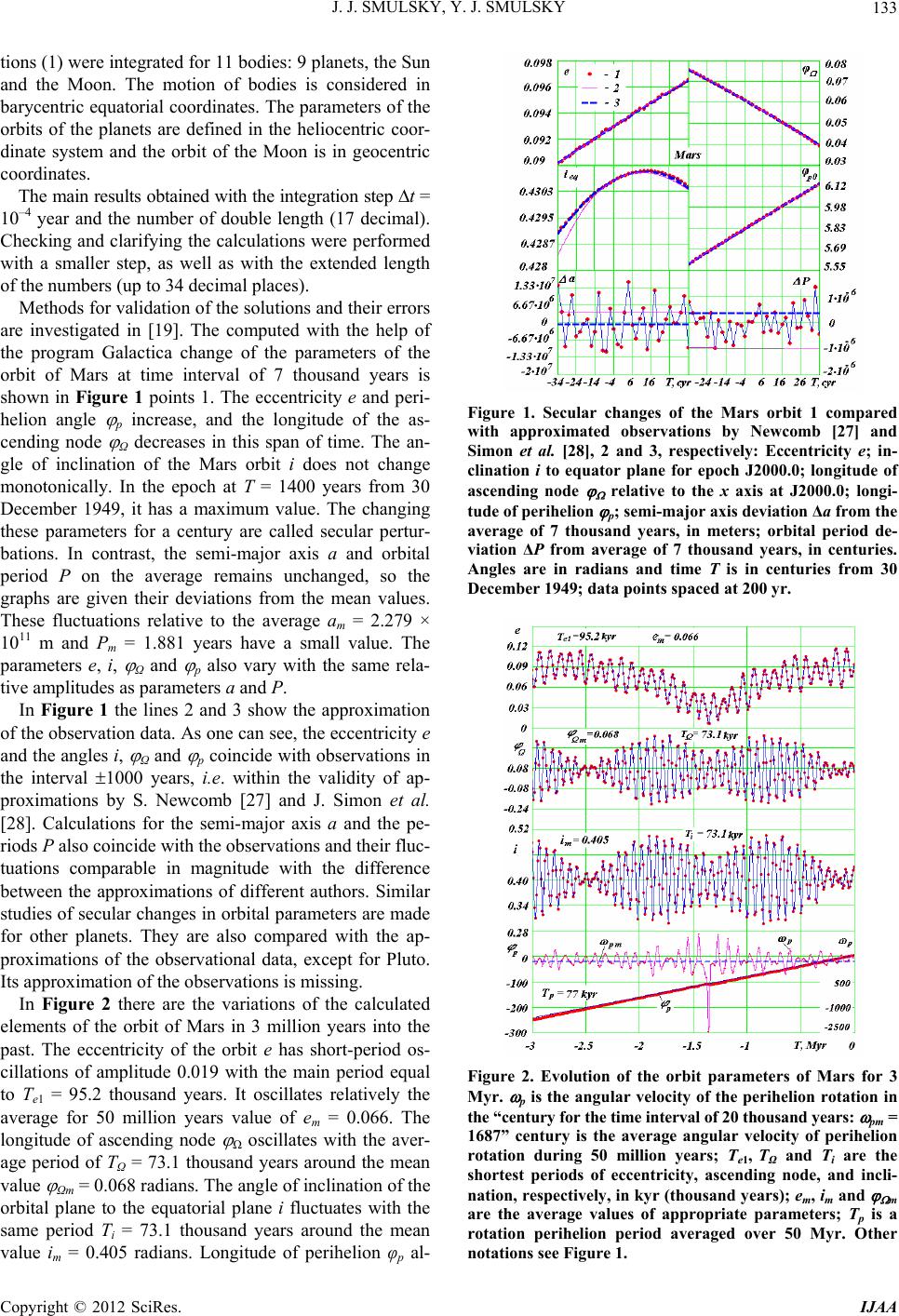 J. J. SMULSKY, Y. J. SMULSKY 133 tions (1) were integrated for 11 bodies: 9 planets, the Sun and the Moon. The motion of bodies is considered in barycentric equatorial coordinates. The parameters of the orbits of the planets are defined in the heliocentric coor- dinate system and the orbit of the Moon is in geocentric coordinates. The main results obtained with the integration step t = 10–4 year and the number of double length (17 decimal). Checking and clarifying the calculations were performed with a smaller step, as well as with the extended length of the numbers (up to 34 decimal places). Methods for validation of the solutions and their errors are investigated in [19]. The computed with the help of the program Galactica change of the parameters of the orbit of Mars at time interval of 7 thousand years is shown in Figure 1 points 1. The eccentricity e and peri- helion angle p increase, and the longitude of the as- cending node Ω decreases in this span of time. The an- gle of inclination of the Mars orbit i does not change monotonically. In the epoch at T = 1400 years from 30 December 1949, it has a maximum value. The changing these parameters for a century are called secular pertur- bations. In contrast, the semi-major axis a and orbital period P on the average remains unchanged, so the graphs are given their deviations from the mean values. These fluctuations relative to the average am = 2.279 × 1011 m and Pm = 1.881 years have a small value. The parameters e, i, Ω and p also vary with the same rela- tive amplitudes as parameters a and P. In Figure 1 the lines 2 and 3 show the approximation of the observation data. As one can see, the eccentricity e and the angles i, Ω and p coincide with observations in the interval 1000 years, i.e. within the validity of ap- proximations by S. Newcomb [27] and J. Simon et al. [28]. Calculations for the semi-major axis a and the pe- riods P also coincide with the observations and their fluc- tuations comparable in magnitude with the difference between the approximations of different authors. Similar studies of secular changes in orbital parameters are made for other planets. They are also compared with the ap- proximations of the observational data, except for Pluto. Its approximation of the observations is missing. In Figure 2 there are the variations of the calculated elements of the orbit of Mars in 3 million years into the past. The eccentricity of the orbit e has short-period os- cillations of amplitude 0.019 with the main period equal to Te1 = 95.2 thousand years. It oscillates relatively the average for 50 million years value of em = 0.066. The longitude of ascending node Ω oscillates with the aver- age period of ТΩ = 73.1 thousand years around the mean value Ωm = 0.068 radians. The angle of inclination of the orbital plane to the equatorial plane i fluctuates with the same period Ti = 73.1 thousand years around the mean value іm = 0.405 radians. Longitude of perihelion φр al- Figure 1. Secular changes of the Mars orbit 1 compared with approximated observations by Newcomb [27] and Simon et al. [28], 2 and 3, respectively: Eccentricity e; in- clination i to equator plane for epoch J2000.0; longitude of ascending node relative to the x axis at J2000.0; longi- tude of perihelion p; semi-major axis deviation Δa from the average of 7 thousand years, in meters; orbital period de- viation ΔP from average of 7 thousand years, in centuries. Angles are in radians and time Т is in centuries from 30 December 1949; data points spaced at 200 yr. Figure 2. Evolution of the orbit parameters of Mars for 3 Myr. p is the angular velocity of the perihelion rotation in the “century for the time interval of 20 thousand years: pm = 1687” century is the average angular velocity of perihelion rotation during 50 million years; Те1, ТΩ and Тi are the shortest periods of eccentricity, ascending node, and incli- nation, respectively, in kyr (thousand years); em, im and m are the average values of appropriate parameters; Тр is a rotation perihelion period averaged over 50 Myr. Other notations see Figure 1. Copyright © 2012 SciRes. IJAA 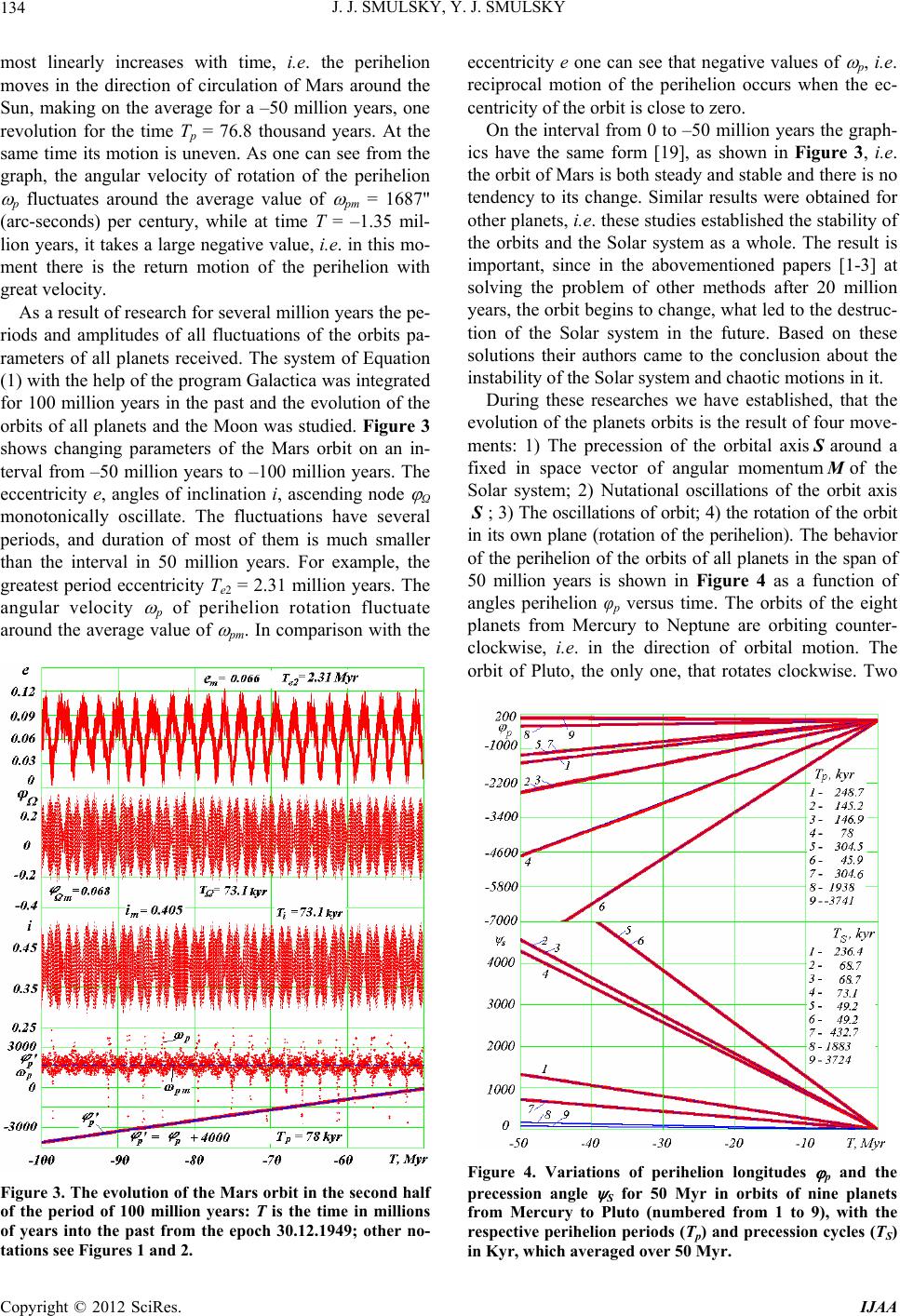 J. J. SMULSKY, Y. J. SMULSKY 134 most linearly increases with time, i.e. the perihelion moves in the direction of circulation of Mars around the Sun, making on the average for a –50 million years, one revolution for the time Tp = 76.8 thousand years. At the same time its motion is uneven. As one can see from the graph, the angular velocity of rotation of the perihelion p fluctuates around the average value of pm = 1687" (arc-seconds) per century, while at time T = –1.35 mil- lion years, it takes a large negative value, i.e. in this mo- ment there is the return motion of the perihelion with great velocity. As a result of research for several million years the pe- riods and amplitudes of all fluctuations of the orbits pa- rameters of all planets received. The system of Equation (1) with the help of the program Galactica was integrated for 100 million years in the past and the evolution of the orbits of all planets and the Moon was studied. Figure 3 shows changing parameters of the Mars orbit on an in- terval from –50 million years to –100 million years. The eccentricity e, angles of inclination i, ascending node Ω monotonically oscillate. The fluctuations have several periods, and duration of most of them is much smaller than the interval in 50 million years. For example, the greatest period eccentricity Te2 = 2.31 million years. The angular velocity p of perihelion rotation fluctuate around the average value of pm. In comparison with the Figure 3. The evolution of the Mars orbit in the second half of the period of 100 million years: T is the time in millions of years into the past from the epoch 30.12.1949; other no- tations see Figures 1 and 2. eccentricity e one can see that negative values of p, i.e. reciprocal motion of the perihelion occurs when the ec- centricity of the orbit is close to zero. On the interval from 0 to –50 million years the graph- ics have the same form [19], as shown in Figure 3, i.e. the orbit of Mars is both steady and stable and there is no tendency to its change. Similar results were obtained for other planets, i.e. these studies established the stability of the orbits and the Solar system as a whole. The result is important, since in the abovementioned papers [1-3] at solving the problem of other methods after 20 million years, the orbit begins to change, what led to the destruc- tion of the Solar system in the future. Based on these solutions their authors came to the conclusion about the instability of the Solar system and chaotic motions in it. During these researches we have established, that the evolution of the planets orbits is the result of four move- ments: 1) The precession of the orbital axis around a fixed in space vector of angular momentumof the Solar system; 2) Nutational oscillations of the orbit axis M ; 3) The oscillations of orbit; 4) the rotation of the orbit in its own plane (rotation of the perihelion). The behavior of the perihelion of the orbits of all planets in the span of 50 million years is shown in Figure 4 as a function of angles perihelion φр versus time. The orbits of the eight planets from Mercury to Neptune are orbiting counter- clockwise, i.e. in the direction of orbital motion. The orbit of Pluto, the only one, that rotates clockwise. Two Figure 4. Variations of perihelion longitudes p and the precession angle S for 50 Myr in orbits of nine planets from Mercury to Pluto (numbered from 1 to 9), with the respective perihelion periods (Tp) and precession cycles (TS) in Kyr, which averaged over 50 Myr. Copyright © 2012 SciRes. IJAA 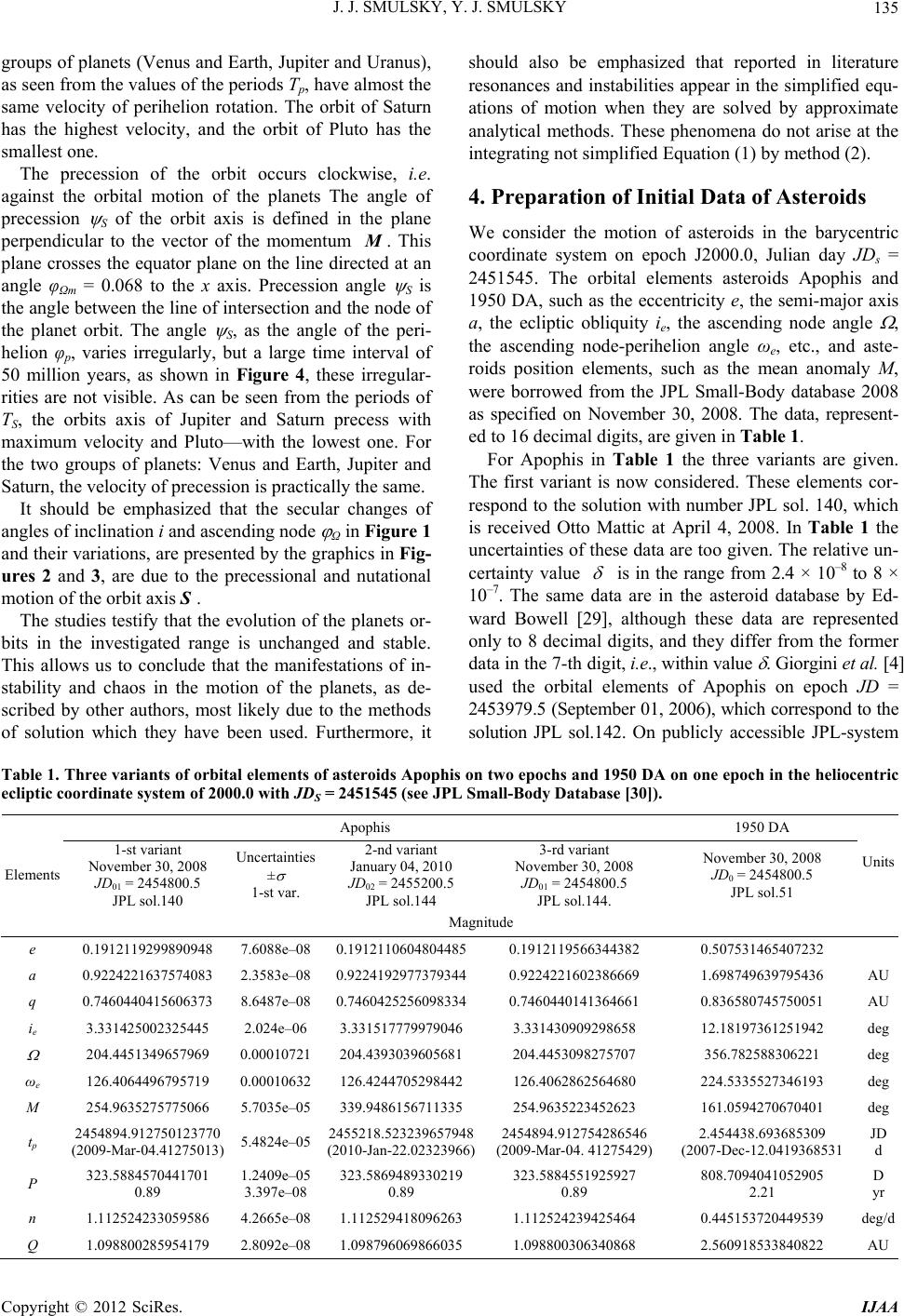 J. J. SMULSKY, Y. J. SMULSKY Copyright © 2012 SciRes. IJAA 135 groups of planets (Venus and Earth, Jupiter and Uranus), as seen from the values of the periods Tp, have almost the same velocity of perihelion rotation. The orbit of Saturn has the highest velocity, and the orbit of Pluto has the smallest one. should also be emphasized that reported in literature resonances and instabilities appear in the simplified equ- ations of motion when they are solved by approximate analytical methods. These phenomena do not arise at the integrating not simplified Equation (1) by method (2). The precession of the orbit occurs clockwise, i.e. against the orbital motion of the planets The angle of precession S of the orbit axis is defined in the plane perpendicular to the vector of the momentum . This plane crosses the equator plane on the line directed at an angle φΩm = 0.068 to the x axis. Precession angle S is the angle between the line of intersection and the node of the planet orbit. The angle S, as the angle of the peri- helion φр, varies irregularly, but a large time interval of 50 million years, as shown in Figure 4, these irregular- rities are not visible. As can be seen from the periods of TS, the orbits axis of Jupiter and Saturn precess with maximum velocity and Pluto—with the lowest one. For the two groups of planets: Venus and Earth, Jupiter and Saturn, the velocity of precession is practically the same. M 4. Preparation of Initial Data of Asteroids We consider the motion of asteroids in the barycentric coordinate system on epoch J2000.0, Julian day JDs = 2451545. The orbital elements asteroids Apophis and 1950 DA, such as the eccentricity e, the semi-major axis a, the ecliptic obliquity ie, the ascending node angle , the ascending node-perihelion angle ωe, etc., and aste- roids position elements, such as the mean anomaly M, were borrowed from the JPL Small-Body database 2008 as specified on November 30, 2008. The data, represent- ed to 16 decimal digits, are given in Table 1. For Apophis in Table 1 the three variants are given. The first variant is now considered. These elements cor- respond to the solution with number JPL sol. 140, which is received Otto Mattic at April 4, 2008. In Table 1 the uncertainties of these data are too given. The relative un- certainty value is in the range from 2.4 × 10–8 to 8 × 10–7. The same data are in the asteroid database by Ed- ward Bowell [29], although these data are represented only to 8 decimal digits, and they differ from the former data in the 7-th digit, i.e., within value . Giorgini et al. [4] used the orbital elements of Apophis on epoch JD = 2453979.5 (September 01, 2006), which correspond to the solution JPL sol.142. On publicly accessible JPL-system It should be emphasized that the secular changes of angles of inclination i and ascending node Ω in Figure 1 and their variations, are presented by the graphics in Fig- ures 2 and 3, are due to the precessional and nutational motion of the orbit axis . The studies testify that the evolution of the planets or- bits in the investigated range is unchanged and stable. This allows us to conclude that the manifestations of in- stability and chaos in the motion of the planets, as de- scribed by other authors, most likely due to the methods of solution which they have been used. Furthermore, it Table 1. Three variants of orbital elements of asteroids Apophis on two epochs and 1950 DA on one epoch in the heliocentric ecliptic coordinate system of 2000.0 with JDS = 2451545 (see JPL Small-Body Database [30]). Apophis 1950 DA 1-st variant November 30, 2008 JD01 = 2454800.5 JPL sol.140 Uncertainties ± 1-st var. 2-nd variant January 04, 2010 JD02 = 2455200.5 JPL sol.144 3-rd variant November 30, 2008 JD01 = 2454800.5 JPL sol.144. November 30, 2008 JD0 = 2454800.5 JPL sol.51 Units Elements Magnitude e 0.1912119299890948 7.6088e–08 0.1912110604804485 0.1912119566344382 0.507531465407232 a 0.9224221637574083 2.3583e–08 0.9224192977379344 0.9224221602386669 1.698749639795436 AU q 0.7460440415606373 8.6487e–08 0.7460425256098334 0.7460440141364661 0.836580745750051 AU ie 3.331425002325445 2.024e–06 3.331517779979046 3.331430909298658 12.18197361251942 deg 204.4451349657969 0.00010721 204.4393039605681 204.4453098275707 356.782588306221 deg ωe 126.4064496795719 0.00010632 126.4244705298442 126.4062862564680 224.5335527346193 deg M 254.9635275775066 5.7035e–05 339.9486156711335 254.9635223452623 161.0594270670401 deg tp 2454894.912750123770 (2009-Mar-04.41275013) 5.4824e–05 2455218.523239657948 (2010-Jan-22.02323966) 2454894.912754286546 (2009-Mar-04. 41275429) 2.454438.693685309 (2007-Dec-12.0419368531 JD d P 323.5884570441701 0.89 1.2409e–05 3.397e–08 323.5869489330219 0.89 323.5884551925927 0.89 808.7094041052905 2.21 D yr n 1.112524233059586 4.2665e–08 1.112529418096263 1.112524239425464 0.445153720449539 deg/d Q 1.098800285954179 2.8092e–08 1.098796069866035 1.098800306340868 2.560918533840822 AU 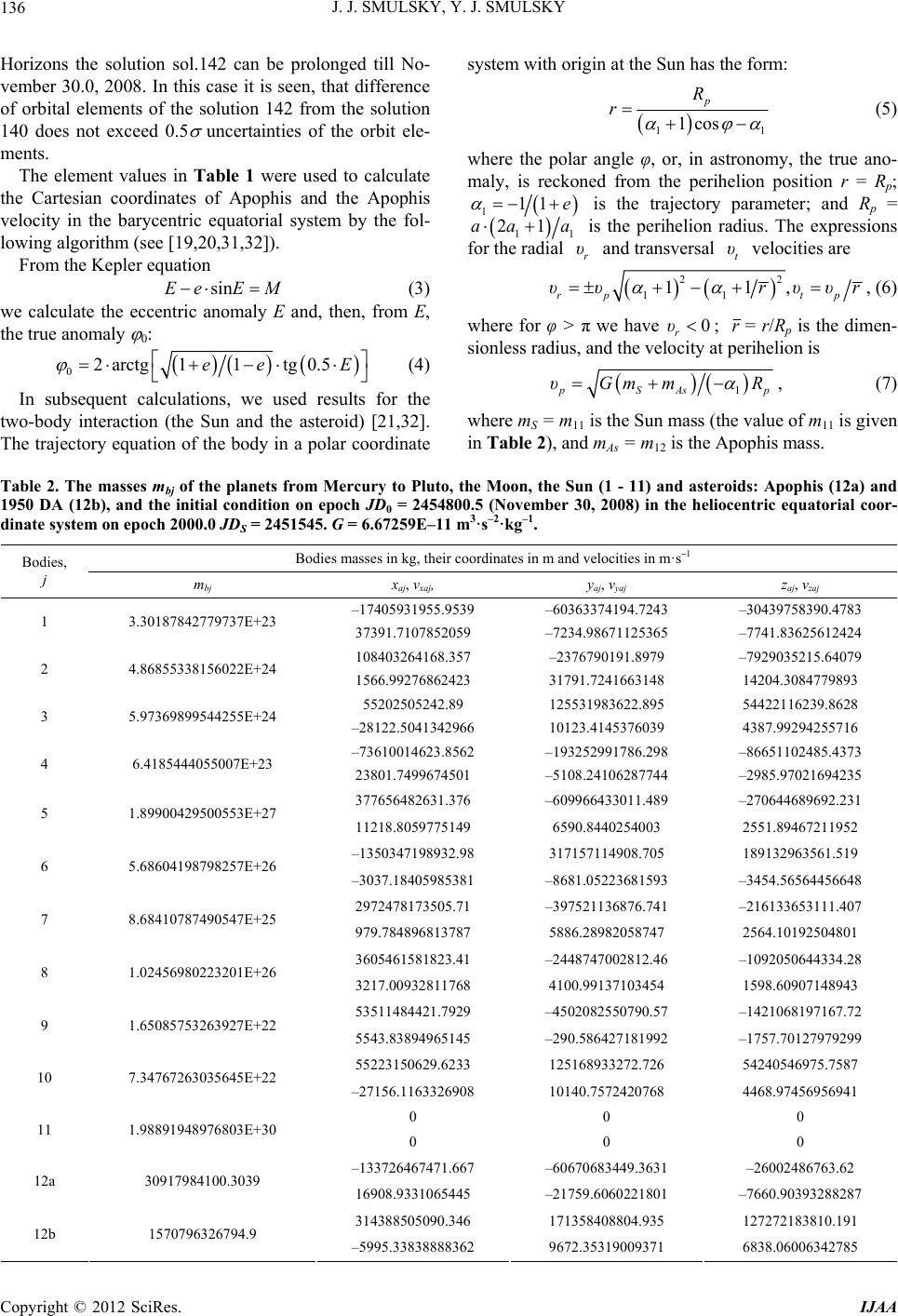 J. J. SMULSKY, Y. J. SMULSKY 136 Horizons the solution sol.142 can be prolonged till No- vember 30.0, 2008. In this case it is seen, that difference of orbital elements of the solution 142 from the solution 140 does not exceed 0.5 uncertainties of the orbit ele- ments. The element values in Table 1 were used to calculate the Cartesian coordinates of Apophis and the Apophis velocity in the barycentric equatorial system by the fol- lowing algorithm (see [19,20,31,32]). From the Kepler equation sinEeE M (3) we calculate the eccentric anomaly E and, then, from E, the true anomaly 0: 02 arctg11tg0.5ee E (4) In subsequent calculations, we used results for the two-body interaction (the Sun and the asteroid) [21,32]. The trajectory equation of the body in a polar coordinate system with origin at the Sun has the form: 11 1cos p R r (5) where the polar angle φ, or, in astronomy, the true ano- maly, is reckoned from the perihelion position r = Rp; 111 e is the trajectory parameter; and Rp = 11 r υ 21aa a is the perihelion radius. The expressions for the radial and transversal velocities are t υ 22 11 11, rp tp υυ rυυr , (6) where for φ > π we have ; 0 r υ = r/Rp is the dimen- sionless radius, and the velocity at perihelion is 1pSAs υGm mR p , (7) where mS = m11 is the Sun mass (the value of m11 is given in Table 2), and mAs = m12 is the Apophis mass. Table 2. The masses mbj of the planets from Mercury to Pluto, the Moon, the Sun (1 - 11) and asteroids: Apophis (12a) and 1950 DA (12b), and the initial condition on epoch JD0 = 2454800.5 (November 30, 2008) in the heliocentric equatorial coor- dinate system on epoch 2000.0 JDS = 2451545. G = 6.67259E–11 m3·s–2·kg–1. Bodies masses in kg, their coordinates in m and velocities in m·s–1 Bodies, j mbj xaj, vxaj, yaj, vyaj zaj, vzaj –17405931955.9539 –60363374194.7243 –30439758390.4783 1 3.30187842779737E+23 37391.7107852059 –7234.98671125365 –7741.83625612424 108403264168.357 –2376790191.8979 –7929035215.64079 2 4.86855338156022E+24 1566.99276862423 31791.7241663148 14204.3084779893 55202505242.89 125531983622.895 54422116239.8628 3 5.97369899544255E+24 –28122.5041342966 10123.4145376039 4387.99294255716 –73610014623.8562 –193252991786.298 –86651102485.4373 4 6.4185444055007E+23 23801.7499674501 –5108.24106287744 –2985.97021694235 377656482631.376 –609966433011.489 –270644689692.231 5 1.89900429500553E+27 11218.8059775149 6590.8440254003 2551.89467211952 –1350347198932.98 317157114908.705 189132963561.519 6 5.68604198798257E+26 –3037.18405985381 –8681.05223681593 –3454.56564456648 2972478173505.71 –397521136876.741 –216133653111.407 7 8.68410787490547E+25 979.784896813787 5886.28982058747 2564.10192504801 3605461581823.41 –2448747002812.46 –1092050644334.28 8 1.02456980223201E+26 3217.00932811768 4100.99137103454 1598.60907148943 53511484421.7929 –4502082550790.57 –1421068197167.72 9 1.65085753263927E+22 5543.83894965145 –290.586427181992 –1757.70127979299 55223150629.6233 125168933272.726 54240546975.7587 10 7.34767263035645E+22 –27156.1163326908 10140.7572420768 4468.97456956941 0 0 0 11 1.98891948976803E+30 0 0 0 –133726467471.667 –60670683449.3631 –26002486763.62 12a 30917984100.3039 16908.9331065445 –21759.6060221801 –7660.90393288287 314388505090.346 171358408804.935 127272183810.191 12b 1570796326794.9 –5995.33838888362 9672.35319009371 6838.06006342785 Copyright © 2012 SciRes. IJAA 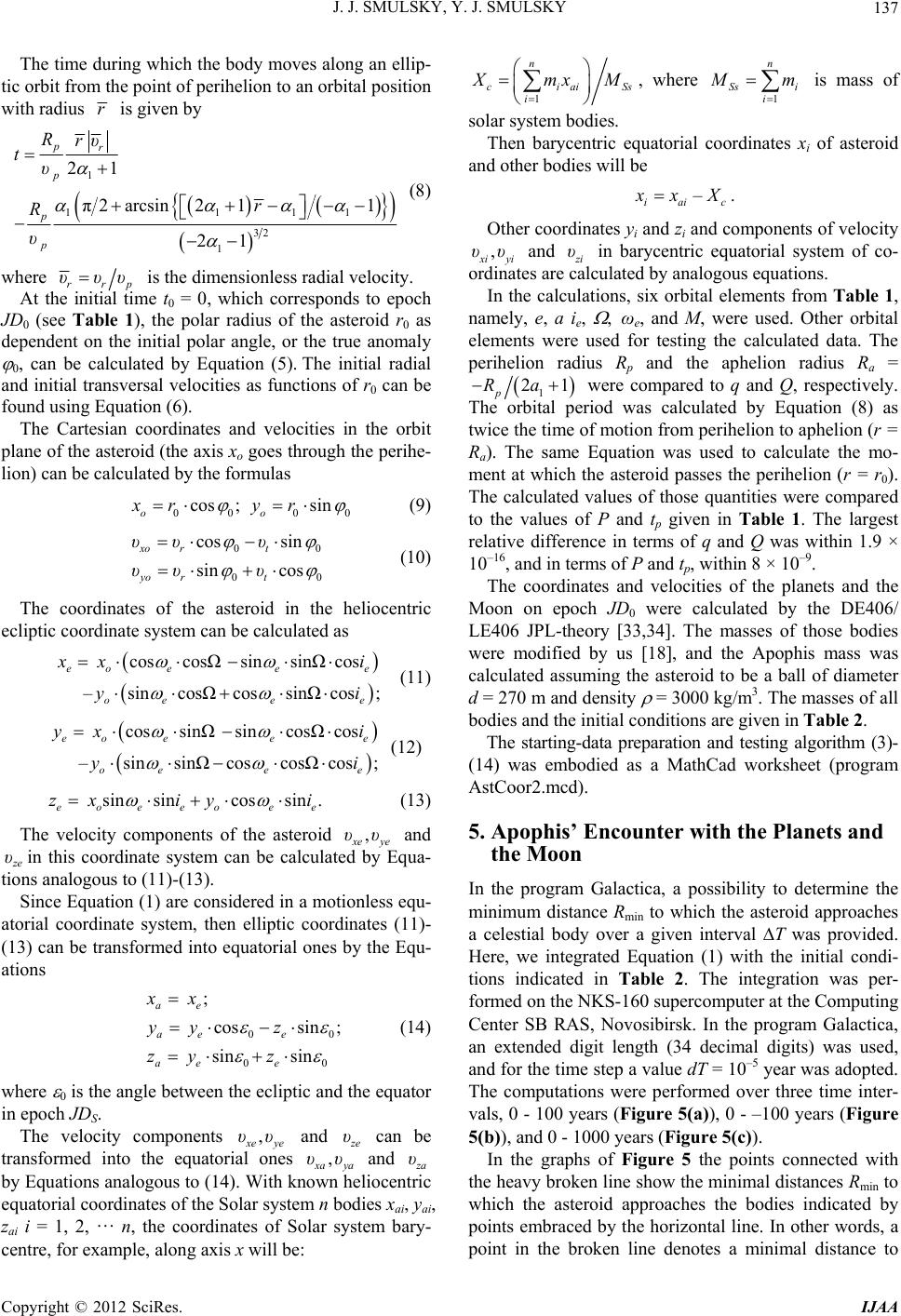 J. J. SMULSKY, Y. J. SMULSKY 137 The time during which the body moves along an ellip- tic orbit from the point of perihelion to an orbital position with radius r is given by 1 111 32 1 21 π2arcsin 211 21 pr p p p Rrυ tυ r R υ 1 (8) where rrp At the initial time t0 = 0, which corresponds to epoch JD0 (see Table 1), the polar radius of the asteroid r0 as dependent on the initial polar angle, or the true anomaly , can be calculated by Equation (5)The initial radial and initial transversal velocities as functions of r0 can be found using Equation (6). υυυ 0 is the dimensionless radial velocity. The Cartesian coordinates and velocities in the orbit plane of the asteroid (the axis xo goes through the perihe- lion) can be calculated by the formulas 00 0 cos ;sin oo xr yr (9) 0 00 cos sin sin cos xo rt yo rt υυ υ υυ υ 0 (10) The coordinates of the asteroid in the heliocentric ecliptic coordinate system can be calculated as coscosΩsin sinΩcos –sincosΩcos sinΩcos ; eo eee oee e x y i i i e (11) cossinΩsin cosΩcos –sinsinΩcos cosΩcos ; eo eee oee e yx i y (12) sinsincossin. eoe eoe zx iyi (13) The velocity components of the asteroid , eye υυ and ze in this coordinate system can be calculated by Equa- tions analogous to (11)-(13). υ Since Equation (1) are considered in a motionless equ- atorial coordinate system, then elliptic coordinates (11)- (13) can be transformed into equatorial ones by the Equ- ations 0 00 ; cossin; sinsin ae ae e ae e xx yy z zy z 0 (14) where 0 is the angle between the ecliptic and the equator in epoch JDS. The velocity components , eye υυ and e υ can be transformed into the equatorial ones , aya υυ and a by Equations analogous to (14). With known heliocentric equatorial coordinates of the Solar system n bodies xai, yai, zai i = 1, 2, … n, the coordinates of Solar system bary- centre, for example, along axis x will be: υ 1 n ci aiSs i mx M , where 1 n Ss i i m is mass of solar system bodies. Then barycentric equatorial coordinates xi of asteroid and other bodies will be – iai c xX . Other coordinates yi and zi and components of velocity , iyi υυ and i υ in barycentric equatorial system of co- ordinates are calculated by analogous equations. In the calculations, six orbital elements from Table 1, namely, e, a ie, , ωe, and M, were used. Other orbital elements were used for testing the calculated data. The perihelion radius Rp and the aphelion radius Ra = 1 21 p Ra were compared to q and Q, respectively. The orbital period was calculated by Equation (8) as twice the time of motion from perihelion to aphelion (r = Ra). The same Equation was used to calculate the mo- ment at which the asteroid passes the perihelion (r = r0). The calculated values of those quantities were compared to the values of P and tp given in Table 1. The largest relative difference in terms of q and Q was within 1.9 × 10–16, and in terms of P and tp, within 8 × 10–9. The coordinates and velocities of the planets and the Moon on epoch JD0 were calculated by the DE406/ LE406 JPL-theory [33,34]. The masses of those bodies were modified by us [18], and the Apophis mass was calculated assuming the asteroid to be a ball of diameter d = 270 m and density = 3000 kg/m3. The masses of all bodies and the initial conditions are given in Table 2. The starting-data preparation and testing algorithm (3)- (14) was embodied as a MathCad worksheet (program AstCoor2.mcd). 5. Apophis’ Encounter with the Planets and the Moon In the program Galactica, a possibility to determine the minimum distance Rmin to which the asteroid approaches a celestial body over a given interval T was provided. Here, we integrated Equation (1) with the initial condi- tions indicated in Table 2. The integration was per- formed on the NKS-160 supercomputer at the Computing Center SB RAS, Novosibirsk. In the program Galactica, an extended digit length (34 decimal digits) was used, and for the time step a value dT = 10–5 year was adopted. The computations were performed over three time inter- vals, 0 - 100 years (Figure 5(a)), 0 - –100 years (Figure 5(b)), and 0 - 1000 years (Figure 5(c)). In the graphs of Figure 5 the points connected with the heavy broken line show the minimal distances Rmin to which the asteroid approaches the bodies indicated by points embraced by the horizontal line. In other words, a point in the broken line denotes a minimal distance to Copyright © 2012 SciRes. IJAA 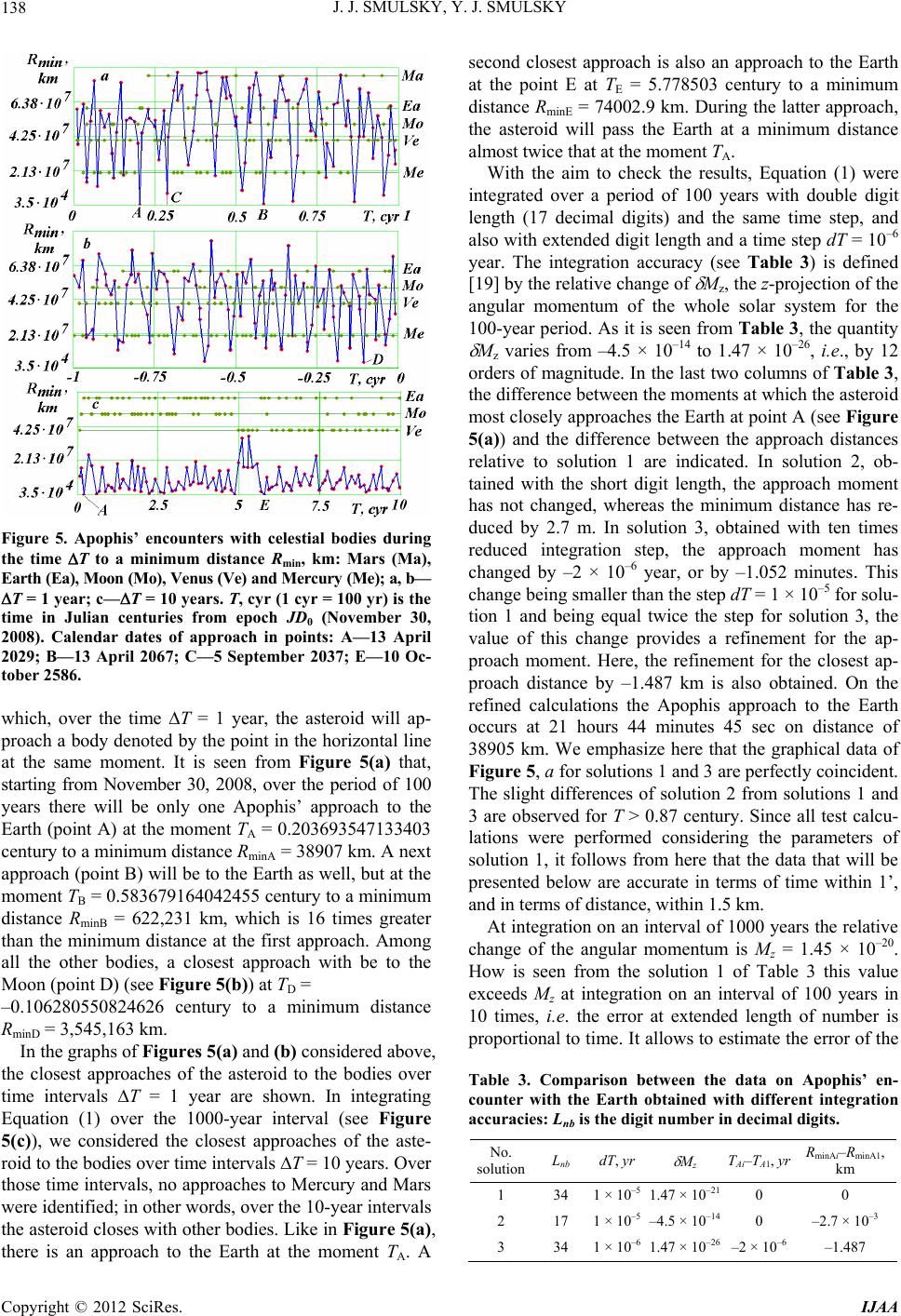 J. J. SMULSKY, Y. J. SMULSKY 138 Figure 5. Apophis’ encounters with celestial bodies during the time T to a minimum distance Rmin, km: Mars (Ma), Earth (Ea), Moon (Mo), Venus (Ve) and Mercury (Me); a, b— T = 1 year; c—T = 10 years. T, cyr (1 cyr = 100 yr) is the time in Julian centuries from epoch JD0 (November 30, 2008). Calendar dates of approach in points: A—13 April 2029; B—13 April 2067; C—5 September 2037; E—10 Oc- tober 2586. which, over the time T = 1 year, the asteroid will ap- proach a body denoted by the point in the horizontal line at the same moment. It is seen from Figure 5(a) that, starting from November 30, 2008, over the period of 100 years there will be only one Apophis’ approach to the Earth (point A) at the moment TA = 0.203693547133403 century to a minimum distance RminA = 38907 km. A next approach (point B) will be to the Earth as well, but at the moment TB = 0.583679164042455 century to a minimum distance RminB = 622,231 km, which is 16 times greater than the minimum distance at the first approach. Among all the other bodies, a closest approach with be to the Moon (point D) (see Figure 5(b)) at TD = –0.106280550824626 century to a minimum distance RminD = 3,545,163 km. In the graphs of Figures 5(a) and (b) considered above, the closest approaches of the asteroid to the bodies over time intervals T = 1 year are shown. In integrating Equation (1) over the 1000-year interval (see Figure 5(c)), we considered the closest approaches of the aste- roid to the bodies over time intervals T = 10 years. Over those time intervals, no approaches to Mercury and Mars were identified; in other words, over the 10-year intervals the asteroid closes with other bodies. Like in Figure 5(a), there is an approach to the Earth at the moment TA. A second closest approach is also an approach to the Earth at the point Е at TE = 5.778503 century to a minimum distance RminE = 74002.9 km. During the latter approach, the asteroid will pass the Earth at a minimum distance almost twice that at the moment TA. With the aim to check the results, Equation (1) were integrated over a period of 100 years with double digit length (17 decimal digits) and the same time step, and also with extended digit length and a time step dT = 10–6 year. The integration accuracy (see Table 3) is defined [19] by the relative change of Mz, the z-projection of the angular momentum of the whole solar system for the 100-year period. As it is seen from Table 3, the quantity Mz varies from –4.5 × 10–14 to 1.47 × 10–26, i.e., by 12 orders of magnitude. In the last two columns of Table 3, the difference between the moments at which the asteroid most closely approaches the Earth at point A (see Figure 5(a)) and the difference between the approach distances relative to solution 1 are indicated. In solution 2, ob- tained with the short digit length, the approach moment has not changed, whereas the minimum distance has re- duced by 2.7 m. In solution 3, obtained with ten times reduced integration step, the approach moment has changed by –2 × 10–6 year, or by –1.052 minutes. This change being smaller than the step dT = 1 × 10–5 for solu- tion 1 and being equal twice the step for solution 3, the value of this change provides a refinement for the ap- proach moment. Here, the refinement for the closest ap- proach distance by –1.487 km is also obtained. On the refined calculations the Apophis approach to the Earth occurs at 21 hours 44 minutes 45 sec on distance of 38905 km. We emphasize here that the graphical data of Figure 5, a for solutions 1 and 3 are perfectly coincident. The slight differences of solution 2 from solutions 1 and 3 are observed for Т > 0.87 century. Since all test calcu- lations were performed considering the parameters of solution 1, it follows from here that the data that will be presented below are accurate in terms of time within 1’, and in terms of distance, within 1.5 km. At integration on an interval of 1000 years the relative change of the angular momentum is Mz = 1.45 × 10–20. How is seen from the solution 1 of Table 3 this value exceeds Mz at integration on an interval of 100 years in 10 times, i.e. the error at extended length of number is proportional to time. It allows to estimate the error of the Table 3. Comparison between the data on Apophis’ en- counter with the Earth obtained with different integration accuracies: Lnb is the digit number in decimal digits. No. solution Lnb dT, yr Mz TAi–TA1, yr RminAi–Rmin A 1, km 1 34 1 × 10–5 1.47 × 10–21 0 0 2 17 1 × 10–5 –4.5 × 10–14 0 –2.7 × 10–3 3 34 1 × 10–6 1.47 × 10–26 –2 × 10–6 –1.487 Copyright © 2012 SciRes. IJAA 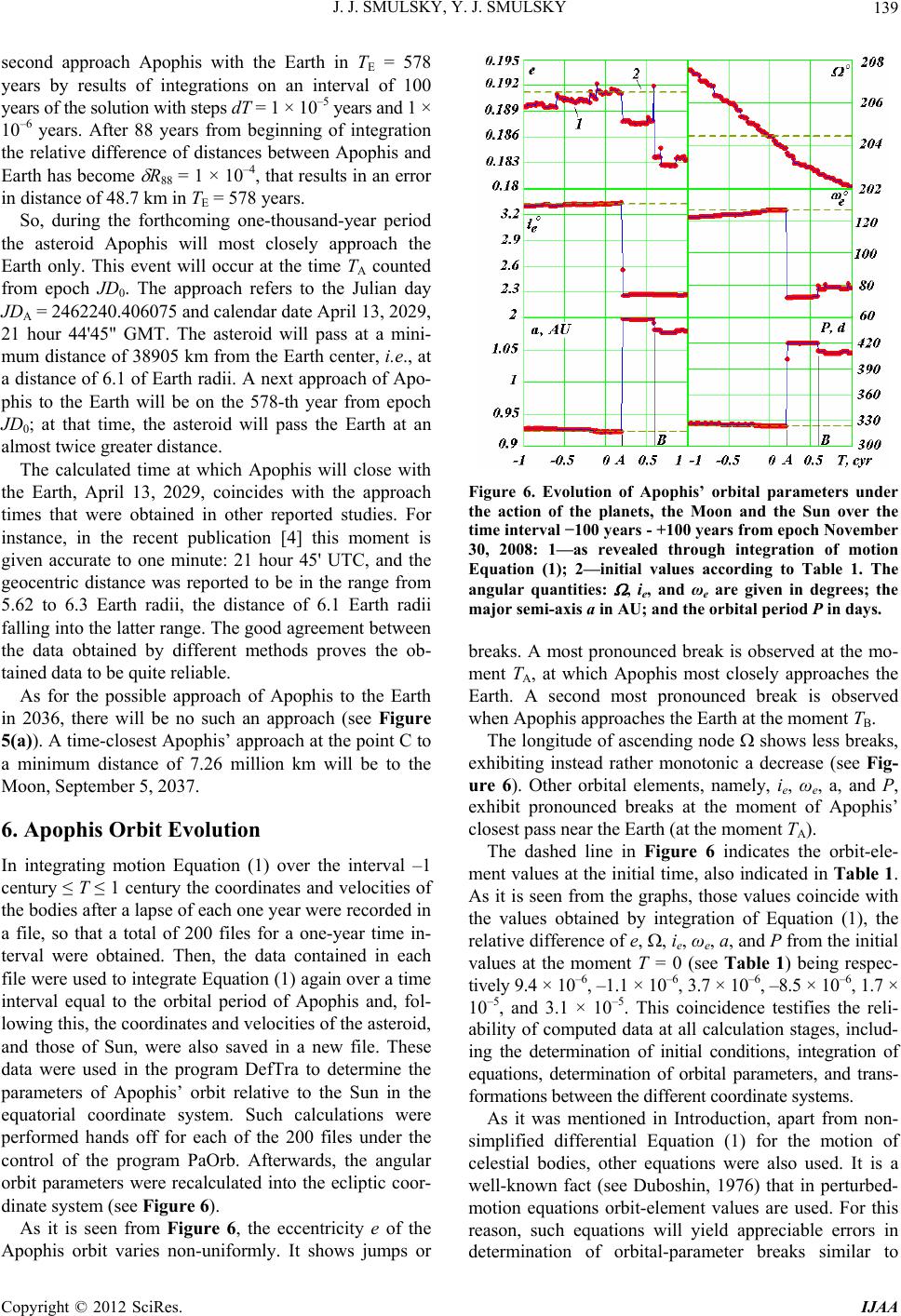 J. J. SMULSKY, Y. J. SMULSKY 139 second approach Apophis with the Earth in TE = 578 years by results of integrations on an interval of 100 years of the solution with steps dT = 1 × 10–5 years and 1 × 10–6 years. After 88 years from beginning of integration the relative difference of distances between Apophis and Earth has become R88 = 1 × 10–4, that results in an error in distance of 48.7 km in TE = 578 years. So, during the forthcoming one-thousand-year period the asteroid Apophis will most closely approach the Earth only. This event will occur at the time TA counted from epoch JD0. The approach refers to the Julian day JDA = 2462240.406075 and calendar date April 13, 2029, 21 hour 44'45" GMT. The asteroid will pass at a mini- mum distance of 38905 km from the Earth center, i.e., at a distance of 6.1 of Earth radii. A next approach of Apo- phis to the Earth will be on the 578-th year from epoch JD0; at that time, the asteroid will pass the Earth at an almost twice greater distance. The calculated time at which Apophis will close with the Earth, April 13, 2029, coincides with the approach times that were obtained in other reported studies. For instance, in the recent publication [4] this moment is given accurate to one minute: 21 hour 45' UTC, and the geocentric distance was reported to be in the range from 5.62 to 6.3 Earth radii, the distance of 6.1 Earth radii falling into the latter range. The good agreement between the data obtained by different methods proves the ob- tained data to be quite reliable. As for the possible approach of Apophis to the Earth in 2036, there will be no such an approach (see Figure 5(a)). A time-closest Apophis’ approach at the point C to a minimum distance of 7.26 million km will be to the Moon, September 5, 2037. 6. Apophis Orbit Evolution In integrating motion Equation (1) over the interval –1 century ≤ T ≤ 1 century the coordinates and velocities of the bodies after a lapse of each one year were recorded in a file, so that a total of 200 files for a one-year time in- terval were obtained. Then, the data contained in each file were used to integrate Equation (1) again over a time interval equal to the orbital period of Apophis and, fol- lowing this, the coordinates and velocities of the asteroid, and those of Sun, were also saved in a new file. These data were used in the program DefTra to determine the parameters of Apophis’ orbit relative to the Sun in the equatorial coordinate system. Such calculations were performed hands off for each of the 200 files under the control of the program PaOrb. Afterwards, the angular orbit parameters were recalculated into the ecliptic coor- dinate system (see Figure 6). As it is seen from Figure 6, the eccentricity е of the Apophis orbit varies non-uniformly. It shows jumps or Figure 6. Evolution of Apophis’ orbital parameters under the action of the planets, the Moon and the Sun over the time interval −100 years - +100 years from epoch November 30, 2008: 1—as revealed through integration of motion Equation (1); 2—initial values according to Table 1. The angular quantities: , i e, and ωe are given in degrees; the major semi-axis a in AU; and the orbital period P in days. breaks. A most pronounced break is observed at the mo- ment TA, at which Apophis most closely approaches the Earth. A second most pronounced break is observed when Apophis approaches the Earth at the moment TB. The longitude of ascending node shows less breaks, exhibiting instead rather monotonic a decrease (see Fig- ure 6). Other orbital elements, namely, ie, ωe, a, and P, exhibit pronounced breaks at the moment of Apophis’ closest pass near the Earth (at the moment TA). The dashed line in Figure 6 indicates the orbit-ele- ment values at the initial time, also indicated in Table 1. As it is seen from the graphs, those values coincide with the values obtained by integration of Equation (1), the relative difference of e, , ie, ωe, a, and P from the initial values at the moment T = 0 (see Table 1) being respec- tively 9.4 × 10–6, –1.1 × 10–6, 3.7 × 10–6, –8.5 × 10–6, 1.7 × 10–5, and 3.1 × 10–5. This coincidence testifies the reli- ability of computed data at all calculation stages, includ- ing the determination of initial conditions, integration of equations, determination of orbital parameters, and trans- formations between the different coordinate systems. As it was mentioned in Introduction, apart from non- simplified differential Equation (1) for the motion of celestial bodies, other equations were also used. It is a well-known fact (see Duboshin, 1976) that in perturbed- motion equations orbit-element values are used. For this reason, such equations will yield appreciable errors in determination of orbital-parameter breaks similar to Copyright © 2012 SciRes. IJAA 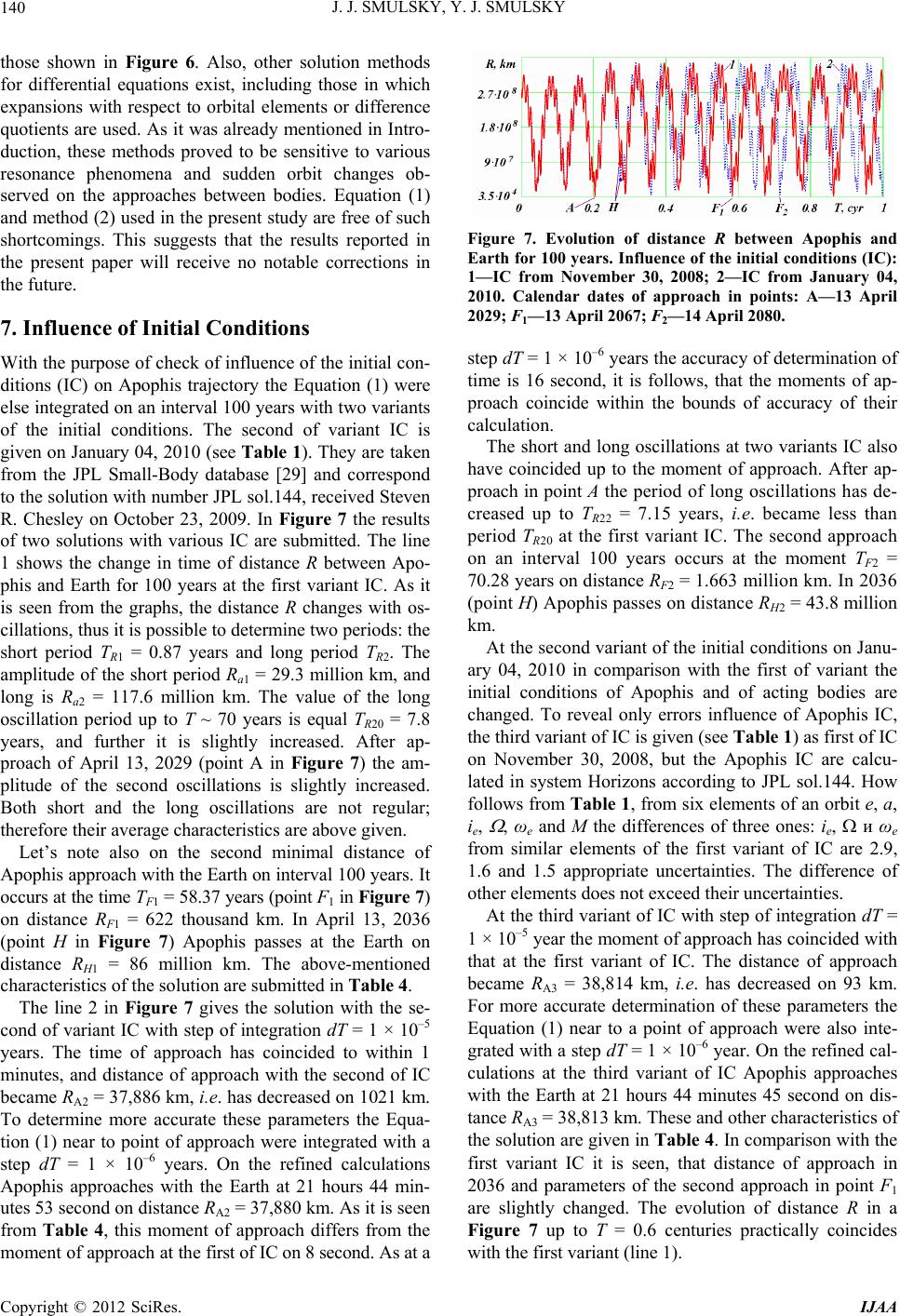 J. J. SMULSKY, Y. J. SMULSKY 140 those shown in Figure 6. Also, other solution methods for differential equations exist, including those in which expansions with respect to orbital elements or difference quotients are used. As it was already mentioned in Intro- duction, these methods proved to be sensitive to various resonance phenomena and sudden orbit changes ob- served on the approaches between bodies. Equation (1) and method (2) used in the present study are free of such shortcomings. This suggests that the results reported in the present paper will receive no notable corrections in the future. 7. Influence of Initial Conditions With the purpose of check of influence of the initial con- ditions (IC) on Apophis trajectory the Equation (1) were else integrated on an interval 100 years with two variants of the initial conditions. The second of variant IC is given on January 04, 2010 (see Table 1). They are taken from the JPL Small-Body database [29] and correspond to the solution with number JPL sol.144, received Steven R. Chesley on October 23, 2009. In Figure 7 the results of two solutions with various IC are submitted. The line 1 shows the change in time of distance R between Apo- phis and Earth for 100 years at the first variant IC. As it is seen from the graphs, the distance R changes with os- cillations, thus it is possible to determine two periods: the short period TR1 = 0.87 years and long period TR2. The amplitude of the short period Ra1 = 29.3 million km, and long is Ra2 = 117.6 million km. The value of the long oscillation period up to T ~ 70 years is equal TR20 = 7.8 years, and further it is slightly increased. After ap- proach of April 13, 2029 (point A in Figure 7) the am- plitude of the second oscillations is slightly increased. Both short and the long oscillations are not regular; therefore their average characteristics are above given. Let’s note also on the second minimal distance of Apophis approach with the Earth on interval 100 years. It occurs at the time TF1 = 58.37 years (point F1 in Figure 7) on distance RF1 = 622 thousand km. In April 13, 2036 (point H in Figure 7) Apophis passes at the Earth on distance RH1 = 86 million km. The above-mentioned characteristics of the solution are submitted in Table 4. The line 2 in Figure 7 gives the solution with the se- cond of variant IC with step of integration dT = 1 × 10–5 years. The time of approach has coincided to within 1 minutes, and distance of approach with the second of IC became RA2 = 37,886 km, i.e. has decreased on 1021 km. To determine more accurate these parameters the Equa- tion (1) near to point of approach were integrated with a step dT = 1 × 10–6 years. On the refined calculations Apophis approaches with the Earth at 21 hours 44 min- utes 53 second on distance RA2 = 37,880 km. As it is seen from Table 4, this moment of approach differs from the moment of approach at the first of IC on 8 second. As at a Figure 7. Evolution of distance R between Apophis and Earth for 100 years. Influence of the initial conditions (IC): 1—IC from November 30, 2008; 2—IC from January 04, 2010. Calendar dates of approach in points: A—13 April 2029; F1—13 April 2067; F2—14 April 2080. step dT = 1 × 10–6 years the accuracy of determination of time is 16 second, it is follows, that the moments of ap- proach coincide within the bounds of accuracy of their calculation. The short and long oscillations at two variants IC also have coincided up to the moment of approach. After ap- proach in point A the period of long oscillations has de- creased up to TR22 = 7.15 years, i.e. became less than period TR20 at the first variant IC. The second approach on an interval 100 years occurs at the moment TF2 = 70.28 years on distance RF2 = 1.663 million km. In 2036 (point H) Apophis passes on distance RH2 = 43.8 million km. At the second variant of the initial conditions on Janu- ary 04, 2010 in comparison with the first of variant the initial conditions of Apophis and of acting bodies are changed. To reveal only errors influence of Apophis IC, the third variant of IC is given (see Table 1) as first of IC on November 30, 2008, but the Apophis IC are calcu- lated in system Horizons according to JPL sol.144. How follows from Table 1, from six elements of an orbit e, a, ie, , ωe and M the differences of three ones: ie, и ωe from similar elements of the first variant of IC are 2.9, 1.6 and 1.5 appropriate uncertainties. The difference of other elements does not exceed their uncertainties. At the third variant of IC with step of integration dT = 1 × 10–5 year the moment of approach has coincided with that at the first variant of IC. The distance of approach became RA3 = 38,814 km, i.e. has decreased on 93 km. For more accurate determination of these parameters the Equation (1) near to a point of approach were also inte- grated with a step dT = 1 × 10–6 year. On the refined cal- culations at the third variant of IC Apophis approaches with the Earth at 21 hours 44 minutes 45 second on dis- tance RA3 = 38,813 km. These and other characteristics of the solution are given in Table 4. In comparison with the first variant IC it is seen, that distance of approach in 2036 and parameters of the second approach in point F1 are slightly changed. The evolution of distance R in a Figure 7 up to T = 0.6 centuries practically coincides with the first variant (line 1). Copyright © 2012 SciRes. IJAA 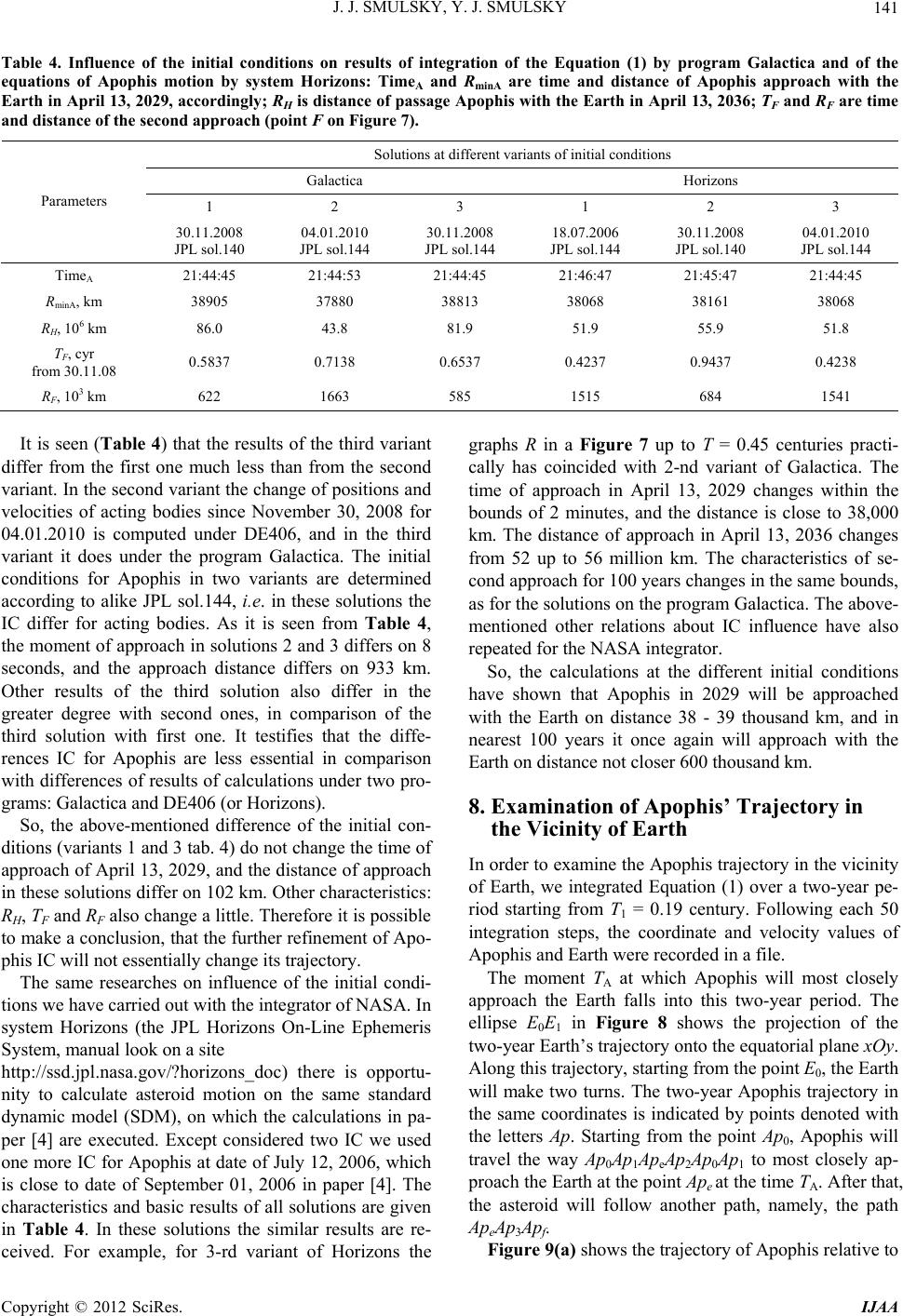 J. J. SMULSKY, Y. J. SMULSKY Copyright © 2012 SciRes. IJAA 141 Table 4. Influence of the initial conditions on results of integration of the Equation (1) by program Galactica and of the equations of Apophis motion by system Horizons: TimeA and Rmin A are time and distance of Apophis approach with the Earth in April 13, 2029, accordingly; RH is distance of passage Apophis with the Earth in April 13, 2036; TF and RF are time and distance of the second approach (point F on Figure 7). Solutions at different variants of initial conditions Galactica Horizons 1 2 3 1 2 3 Parameters 30.11.2008 JPL sol.140 04.01.2010 JPL sol.144 30.11.2008 JPL sol.144 18.07.2006 JPL sol.144 30.11.2008 JPL sol.140 04.01.2010 JPL sol.144 TimeA 21:44:45 21:44:53 21:44:45 21:46:47 21:45:47 21:44:45 RminA , km 38905 37880 38813 38068 38161 38068 RH, 106 km 86.0 43.8 81.9 51.9 55.9 51.8 TF, cyr from 30.11.08 0.5837 0.7138 0.6537 0.4237 0.9437 0.4238 RF, 103 km 622 1663 585 1515 684 1541 It is seen (Table 4) that the results of the third variant differ from the first one much less than from the second variant. In the second variant the change of positions and velocities of acting bodies since November 30, 2008 for 04.01.2010 is computed under DE406, and in the third variant it does under the program Galactica. The initial conditions for Apophis in two variants are determined according to alike JPL sol.144, i.e. in these solutions the IC differ for acting bodies. As it is seen from Table 4, the moment of approach in solutions 2 and 3 differs on 8 seconds, and the approach distance differs on 933 km. Other results of the third solution also differ in the greater degree with second ones, in comparison of the third solution with first one. It testifies that the diffe- rences IC for Apophis are less essential in comparison with differences of results of calculations under two pro- grams: Galactica and DE406 (or Horizons). So, the above-mentioned difference of the initial con- ditions (variants 1 and 3 tab. 4) do not change the time of approach of April 13, 2029, and the distance of approach in these solutions differ on 102 km. Other characteristics: RH, TF and RF also change a little. Therefore it is possible to make a conclusion, that the further refinement of Apo- phis IC will not essentially change its trajectory. The same researches on influence of the initial condi- tions we have carried out with the integrator of NASA. In system Horizons (the JPL Horizons On-Line Ephemeris System, manual look on a site http://ssd.jpl.nasa.gov/?horizons_doc) there is opportu- nity to calculate asteroid motion on the same standard dynamic model (SDM), on which the calculations in pa- per [4] are executed. Except considered two IC we used one more IC for Apophis at date of July 12, 2006, which is close to date of September 01, 2006 in paper [4]. The characteristics and basic results of all solutions are given in Table 4. In these solutions the similar results are re- ceived. For example, for 3-rd variant of Horizons the graphs R in a Figure 7 up to T = 0.45 centuries practi- cally has coincided with 2-nd variant of Galactica. The time of approach in April 13, 2029 changes within the bounds of 2 minutes, and the distance is close to 38,000 km. The distance of approach in April 13, 2036 changes from 52 up to 56 million km. The characteristics of se- cond approach for 100 years changes in the same bounds, as for the solutions on the program Galactica. The above- mentioned other relations about IC influence have also repeated for the NASA integrator. So, the calculations at the different initial conditions have shown that Apophis in 2029 will be approached with the Earth on distance 38 - 39 thousand km, and in nearest 100 years it once again will approach with the Earth on distance not closer 600 thousand km. 8. Examination of Apophis’ Trajectory in the Vicinity of Earth In order to examine the Apophis trajectory in the vicinity of Earth, we integrated Equation (1) over a two-year pe- riod starting from T1 = 0.19 century. Following each 50 integration steps, the coordinate and velocity values of Apophis and Earth were recorded in a file. The moment TA at which Apophis will most closely approach the Earth falls into this two-year period. The ellipse E0E1 in Figure 8 shows the projection of the two-year Earth’s trajectory onto the equatorial plane xOy. Along this trajectory, starting from the point E0, the Earth will make two turns. The two-year Apophis trajectory in the same coordinates is indicated by points denoted with the letters Ap. Starting from the point Ap0, Apophis will travel the way Ap0Ap1ApeAp2Ap0Ap 1 to most closely ap- proach the Earth at the point Ape at the time TA. After that, the asteroid will follow another path, namely, the path ApeAp3Apf. Figure 9(a) shows the trajectory of Apophis relative to 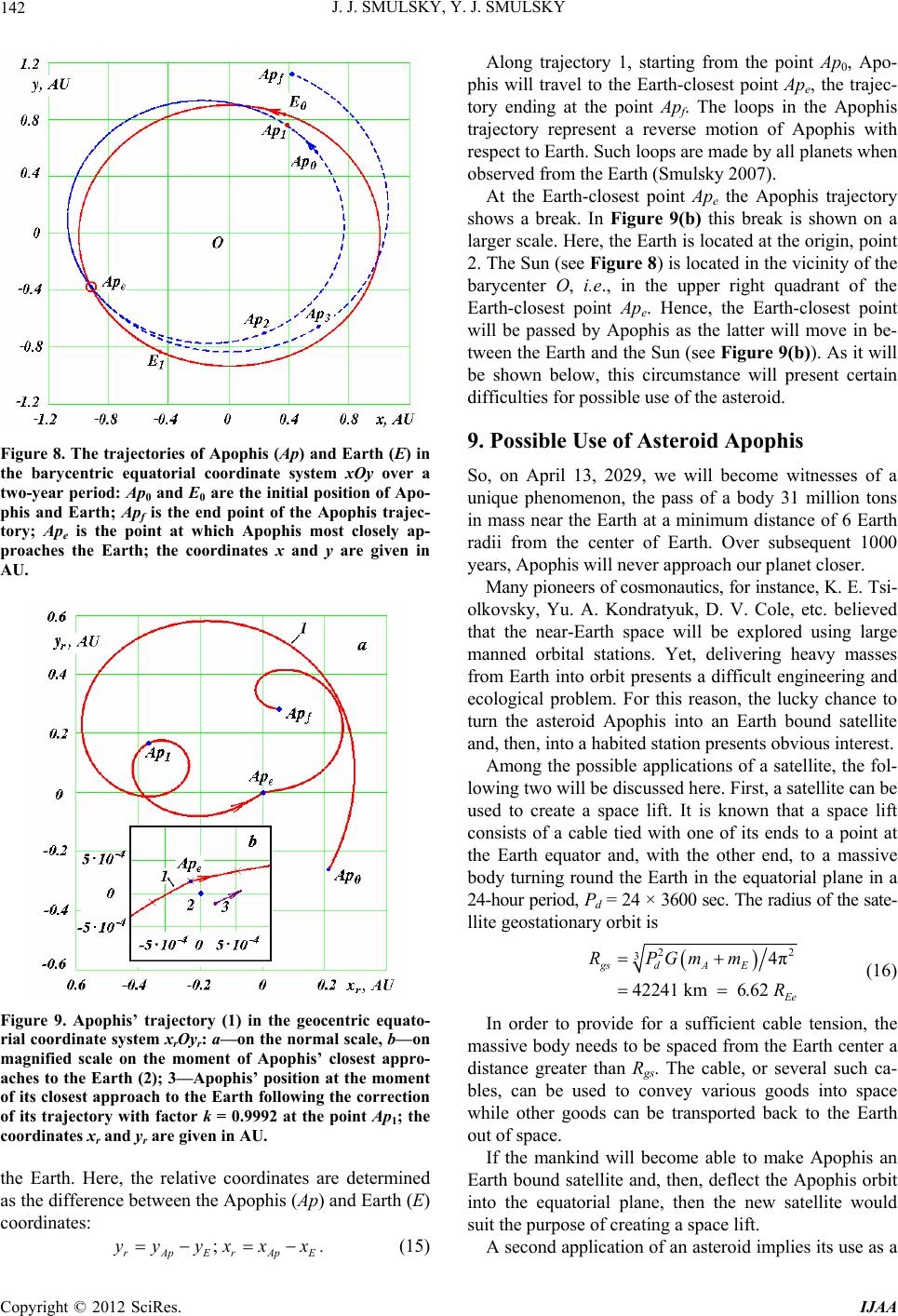 J. J. SMULSKY, Y. J. SMULSKY 142 Figure 8. The trajectories of Apophis (Ap) and Earth (E) in the barycentric equatorial coordinate system xOy over a two-year period: Ap0 and E0 are the initial position of Apo- phis and Earth; Apf is the end point of the Apophis trajec- tory; Ape is the point at which Apophis most closely ap- proaches the Earth; the coordinates x and y are given in AU. Figure 9. Apophis’ trajectory (1) in the geocentric equato- rial coordinate system xrOyr: a—on the normal scale, b—on magnified scale on the moment of Apophis’ closest appro- aches to the Earth (2); 3—Apophis’ position at the moment of its closest approach to the Earth following the correction of its trajectory with factor k = 0.9992 at the point Ap1; the coordinates xr and yr are given in AU. the Earth. Here, the relative coordinates are determined as the difference between the Apophis (Ap) and Earth (E) coordinates: ; rApErAp yyyxx x Along trajectory 1, starting from the point Ap 0, Apo- phis will travel to the Earth-closest point Ape, the trajec- tory ending at the point Apf. The loops in the Apophis trajectory represent a reverse motion of Apophis with respect to Earth. Such loops are made by all planets when observed from the Earth (Smulsky 2007). At the Earth-closest point Ape the Apophis trajectory shows a break. In Figure 9(b) this break is shown on a larger scale. Here, the Earth is located at the origin, point 2. The Sun (see Figure 8) is located in the vicinity of the barycenter O, i.e., in the upper right quadrant of the Earth-closest point Ape. Hence, the Earth-closest point will be passed by Apophis as the latter will move in be- tween the Earth and the Sun (see Figure 9(b)). As it will be shown below, this circumstance will present certain difficulties for possible use of the asteroid. 9. Possible Use of Asteroid Apophis So, on April 13, 2029, we will become witnesses of a unique phenomenon, the pass of a body 31 million tons in mass near the Earth at a minimum distance of 6 Earth radii from the center of Earth. Over subsequent 1000 years, Apophis will never approach our planet closer. Many pioneers of cosmonautics, for instance, K. E. Tsi- olkovsky, Yu. A. Kondratyuk, D. V. Cole, etc. believed that the near-Earth space will be explored using large manned orbital stations. Yet, delivering heavy masses from Earth into orbit presents a difficult engineering and ecological problem. For this reason, the lucky chance to turn the asteroid Apophis into an Earth bound satellite and, then, into a habited station presents obvious interest. Among the possible applications of a satellite, the fol- lowing two will be discussed here. First, a satellite can be used to create a space lift. It is known that a space lift consists of a cable tied with one of its ends to a point at the Earth equator and, with the other end, to a massive body turning round the Earth in the equatorial plane in a 24-hour period, Pd = 24 × 3600 sec. The radius of the sate- llite geostationary orbit is 22 34π 42241 km 6.62 gsdA E e RPGmm R (16) In order to provide for a sufficient cable tension, the massive body needs to be spaced from the Earth center a distance greater than Rgs. The cable, or several such ca- bles, can be used to convey various goods into space while other goods can be transported back to the Earth out of space. If the mankind will become able to make Apophis an Earth bound satellite and, then, deflect the Apophis orbit into the equatorial plane, then the new satellite would suit the purpose of creating a space lift. E . (15) A second application of an asteroid implies its use as a Copyright © 2012 SciRes. IJAA  J. J. SMULSKY, Y. J. SMULSKY 143 “shuttle” for transporting goods to the Moon. Here, the asteroid is to have an elongated orbit with a perihelion radius close to that of a geostationary orbit and an apogee radius approaching the perigee radius of the lunar orbit. In the latter case, at the geostationary-orbit perigee goods would be transferred onto the satellite Apophis and then, at the apogee, those goods would arrive at the Moon. The two applications will entail the necessity of solv- ing many difficult problems which now can seem even unsolvable. On the other hand, none of those problems will be solved at all without making asteroid an Earth satellite. Consider now the possibilities available here. The velocity of the asteroid relative to the Earth at the Earth-closest point Ape is AE = 7.39 km·s–1. The velo- city of an Earth bound satellite orbiting at a fixed dis- tance RminA from the Earth (circular orbit) is v 1 min A3.2 kms CEA E vGmmR (17) For the asteroid to be made an Earth-bound satellite, its velocity AE should be brought close to CE v. We performed integration of Equation (1) assuming the Apophis velocity at the moment TA to be reduced by a factor of 1.9, i.e., the velocity AE = 7.39 km·s–1 at the moment TA was decreased to 3.89 km·s–1. In the later case, Apophis becomes an Earth bound satellite with the following orbit characteristics: eccentricity es1 = 0.476, equator-plane inclination angle is1 = 39.2˚, major semi- axis as1 = 74540 km, and sidereal orbital period Ps1 = 2.344 days. v v We examined the path evolution of the satellite for a period of 100 years. In spite of more pronounced oscilla- tions of the orbital elements of the satellite in comparison with those of planetary orbit elements, the satellite’s ma- jor semi-axis and orbital period proved to fall close to the indicated values. For the relative variations of the two quantities, the following estimates were obtained: | a| < ±2.75 × 10–4 and | P| < ±4.46 × 10–4. Yet, the satellite orbits in a direction opposite both to the Earth rotation direction and the direction of Moon’s orbital motion. That is why the two discussed applications of such a sat- ellite turn to be impossible. Thus, the satellite has to orbit in the same direction in which the Earth rotates. Provided that Apophis (see Fig- ure 9(b)) will round the Earth from the night-side (see point 3) and not from the day-side (see line 1), then, on a decrease of its velocity the satellite will be made a satel- lite orbiting in the required direction. For this matter to be clarified, we have integrated Equation (1) assuming different values of the asteroid ve- locity at the point Аp1 (see Figure 9). This point, located at half the turn from the Earth-closest point Ape, will be passed by Apophis at the time TAp1 = 0.149263369488169 century. At the point Аp1 the projections of the Apophis velocity in the barycentric equatorial coordinate system are 1Apx = –25.6136689 km·s–1, 1Apy = 17.75185451 km·s–1, and 1Apz = 5.95159206 km·s–1. In the numeri- cal experiments, the component values of the satellite velocity were varied to one and the same proportion by multiplying all them by a single factor k, and then Equa- tion (1) were integrated to determine the trajectory of the asteroid. Figure 10 shows the minimum distance to which Apophis will approach the Earth versus the value of k by which the satellite velocity at the point Аp1 was reduced. v v v We found that, on decreasing the value of k (see Fig- ure 10), the asteroid will more closely approach the Earth, and at k = 0.9999564 Apophis will collide with the Earth. On further decrease of asteroid velocity the aste- roid will close with the Earth on the Sun-opposite side, and at k = 0.9992 the asteroid will approach the Earth center (point 3 in Figure 9(b)) to a minimum distance Rmin3 = 39,157 km at the time T3 = 0.2036882 century. This distance Rmin3 roughly equals the distance RminA to which the asteroid was found to approach the Earth cen- ter while moving in between the Earth and the Sun. In this case, the asteroid velocity relative to the Earth is also AE = 7.39 km·s–1. On further decrease of this velocity by a factor of 1.9, i.e., down to 3.89 km·s–1 Apophis will become an Earth bound satellite with the following orbit parameters: eccentricity es2 = 0.486, equ- ator plane inclination angle is2 = 36˚, major semi-axis as2 = 76,480 km, and sidereal period Ps2 = 2.436 day. In addi- tion, we investigated into the path evolution of the Earth bound satellite over a 100-year period. The orbit of the satellite proved to be stable, the satellite orbiting in the same direction as the Moon does. v Figure 10. The minimum distance Rmin to which Apophis will approach the Earth center versus the value of k (k is the velocity reduction factor at the point Ap1 (see Figure 8)). The positive values of Rmin refer to the day-side: The values of Rmi n are given in km; 1—the minimum distance to which Apophis will approach the Earth center on April 13, 2029 (day-side); 2—the minimum distance to which Apophis will approach the Earth center after the orbit correction (night- side); 3—geostationary orbit radius Rgs. Copyright © 2012 SciRes. IJAA 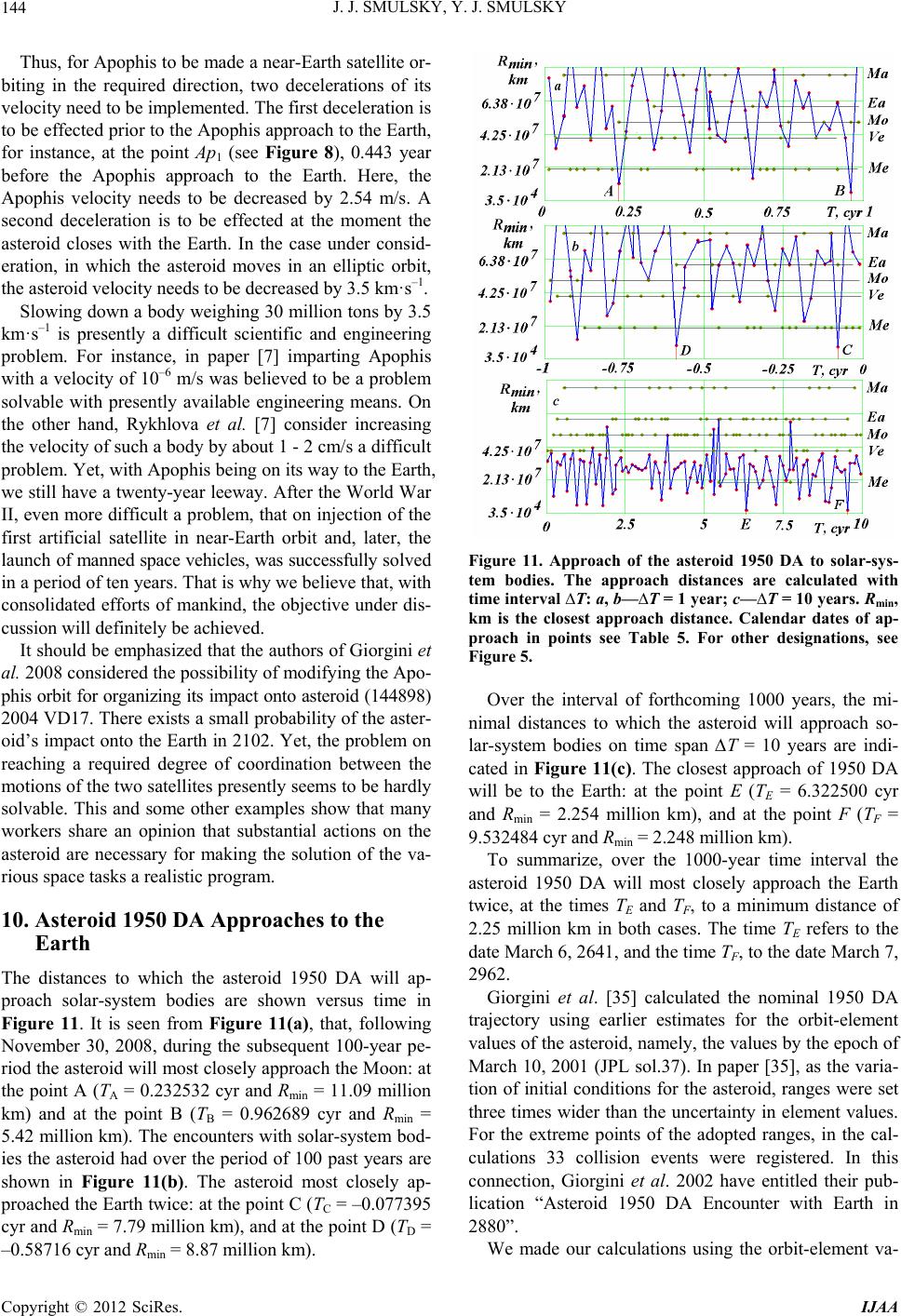 J. J. SMULSKY, Y. J. SMULSKY 144 Thus, for Apophis to be made a near-Earth satellite or- biting in the required direction, two decelerations of its velocity need to be implemented. The first deceleration is to be effected prior to the Apophis approach to the Earth, for instance, at the point Ap1 (see Figure 8), 0.443 year before the Apophis approach to the Earth. Here, the Apophis velocity needs to be decreased by 2.54 m/s. A second deceleration is to be effected at the moment the asteroid closes with the Earth. In the case under consid- eration, in which the asteroid moves in an elliptic orbit, the asteroid velocity needs to be decreased by 3.5 km·s–1. Slowing down a body weighing 30 million tons by 3.5 km·s–1 is presently a difficult scientific and engineering problem. For instance, in paper [7] imparting Apophis with a velocity of 10–6 m/s was believed to be a problem solvable with presently available engineering means. On the other hand, Rykhlova et al. [7] consider increasing the velocity of such a body by about 1 - 2 cm/s a difficult problem. Yet, with Apophis being on its way to the Earth, we still have a twenty-year leeway. After the World War II, even more difficult a problem, that on injection of the first artificial satellite in near-Earth orbit and, later, the launch of manned space vehicles, was successfully solved in a period of ten years. That is why we believe that, with consolidated efforts of mankind, the objective under dis- cussion will definitely be achieved. It should be emphasized that the authors of Giorgini et al. 2008 considered the possibility of modifying the Apo- phis orbit for organizing its impact onto asteroid (144898) 2004 VD17. There exists a small probability of the aster- oid’s impact onto the Earth in 2102. Yet, the problem on reaching a required degree of coordination between the motions of the two satellites presently seems to be hardly solvable. This and some other examples show that many workers share an opinion that substantial actions on the asteroid are necessary for making the solution of the va- rious space tasks a realistic program. 10. Asteroid 1950 DA Approaches to the Earth The distances to which the asteroid 1950 DA will ap- proach solar-system bodies are shown versus time in Figure 11. It is seen from Figure 11(a), that, following November 30, 2008, during the subsequent 100-year pe- riod the asteroid will most closely approach the Moon: at the point A (TA = 0.232532 cyr and Rmin = 11.09 million km) and at the point B (TB = 0.962689 cyr and Rmin = 5.42 million km). The encounters with solar-system bod- ies the asteroid had over the period of 100 past years are shown in Figure 11(b). The asteroid most closely ap- proached the Earth twice: at the point C (TC = –0.077395 cyr and Rmin = 7.79 million km), and at the point D (TD = –0.58716 cyr and Rmin = 8.87 million km). Figure 11. Approach of the asteroid 1950 DA to solar-sys- tem bodies. The approach distances are calculated with time interval ∆T: a, b—∆T = 1 year; c—∆T = 10 years. Rmin, km is the closest approach distance. Calendar dates of ap- proach in points see Table 5. For other designations, see Figure 5. Over the interval of forthcoming 1000 years, the mi- nimal distances to which the asteroid will approach so- lar-system bodies on time span ∆T = 10 years are indi- cated in Figure 11(c). The closest approach of 1950 DA will be to the Earth: at the point E (TE = 6.322500 cyr and Rmin = 2.254 million km), and at the point F (TF = 9.532484 cyr and Rmin = 2.248 million km). To summarize, over the 1000-year time interval the asteroid 1950 DA will most closely approach the Earth twice, at the times TE and TF, to a minimum distance of 2.25 million km in both cases. The time TE refers to the date March 6, 2641, and the time TF, to the date March 7, 2962. Giorgini et al. [35] calculated the nominal 1950 DA trajectory using earlier estimates for the orbit-element values of the asteroid, namely, the values by the epoch of March 10, 2001 (JPL sol.37). In paper [35], as the varia- tion of initial conditions for the asteroid, ranges were set three times wider than the uncertainty in element values. For the extreme points of the adopted ranges, in the cal- culations 33 collision events were registered. In this connection, Giorgini et al. 2002 have entitled their pub- lication “Asteroid 1950 DA Encounter with Earth in 2880”. We made our calculations using the orbit-element va- Copyright © 2012 SciRes. IJAA  J. J. SMULSKY, Y. J. SMULSKY Copyright © 2012 SciRes. IJAA 145 lues of 1950 DA by the epoch of November 30, 2008 (JPL sol.51) (see Table 1). By system Horizons the JPL sol.37 can be prolonged till November 30, 2008. As it is seen in this case, the difference of orbital elements of the solution 37 from the solution 51 on two - three order is less, than uncertainties of orbit elements, i.e. the orbital elements practically coincide. With the aim to trace how the difference methods of calculation has affected the 1950 DA motion, in Table 5 we give a comparison of the approach times of Figure 11 with the time-closest approaches predicted in paper [35]. According to Table 5, the shorter the separation between the approach times (see points C and A) and the start time of calculation (2008-11-30), the better is the coincidence in terms of approach dates and minimal approach dis- tances Rmin. For more remote times (see points D and B) the approach times differ already by 1 day. At the point E, remote from the start time of calculation by 680 year, the approach times differ already by eight days, the approach distances still differing little. At the most remote point F, according to our calculations, the asteroid will approach the Earth in 2962 to a distance of 0.015 AU, whereas, according to the data of Giorgini et al. [35], a most close approach to the Earth, to a shorter distance, will be in 2880. So, our calculations show that the asteroid 1950 DA will not closely approach the Earth. It should be noted that our calculation algorithm for predicting the motion of the asteroid differs substantially from that of Giorgini et al. [35]. We solve non-simplified Equation (1) by a high-precision numerical method. In doing so, we take into account the Newtonian gravitational interaction only. In paper [35], additional weak actions on the asteroid were taken into account. Yet, the position of celestial bodies acting on the asteroid is calculated from the ephemerides of DE-series. Those ephemeredes approxi- mate observational data and, hence, they describe those data to good precision. Yet, the extent to which the pre- dicted motion of celestial bodies deviates from the actual motion of these bodies is the greater the farther the mo- ment of interest is remote from the time interval during which the observations were made. We therefore believe that the difference between the present calculation data for the times 600 and 900 years (points E and F in Table 5) and the data of Giorgini et al. [35] results from the indicated circumstance. 11. Evolution of the 1950 DA Orbit Figure 12 shows the evolution of 1950 DA orbital ele- ments over a 1000-year time interval as revealed in cal- culations made with time span ∆T = 10 years. With the passage of time, the orbit eccentricity e non-monoto- nically increases. The angle of longitude of ascending node , the angle of inclination ie to the ecliptic plane, and the angle of perihelion argument ωe show more monotonic variations. The semi-axis a and the orbital period P both oscillate about some mean values. As it is seen from Figure 12, at the moments of encounter with the Earth, TE and TF, the semi-axis a and the period P show jumps. At the same moments, all the other orbit elements exhibit less pronounced jumps. The dashed line in Figure 12 indicates the initial-time values of orbital elements presented in Table 1. As it is seen from the graphs, these values are perfectly coinci- dent with the values for T = 0 obtained by integration of Equation (1). The relative differences between the values of e, , ie, ωe, a, and P and the initial values of these parameters given in Table 1 are –3.1 × 10–4, –1.6 × 10–5, –6.2 × 10–5, –1.5 × 10–5, –1.5 × 10–5, –1.0 × 10–4, and –3.0 × 10–4, respectively. Such a coincidence validates the calculations at all stages, including the determination of initial conditions, integration of Equation (1), deter- mination of orbital-parameter values, and the transforma- tion between different coordinate systems. It should be noted that the relative difference for the Table 5. Comparison between the data on asteroid 1950 DA encounters with the Earth and Moon: Our data are denoted with characters A, B, C, D, E, F, as in Figure 11, and the data by Giorgini et al. [35] are denoted as Giorg. Source JD, days Date Time, days Body Rmin, AU D Giorg. 2433354 - 1950-03-13 1950-03-12 0.730 0.983 Earth Earth 0.059273 0.059286 C Giorg. 2451973 - 2001-03-05 2001-03-05 0.157 0.058 Earth Earth 0.052075 0.052073 A Giorg. 2463293 - 2032-03-02 2032-03-02 0.222 0.281 Moon Earth 0.074158 0.075751 B Giorg. 2489962 - 2105-03-09 2105-03-10 0.224 0.069 Moon Earth 0.036260 0.036316 E Giorg. 2685729 - 2641-03-06 2641-03-14 0.338 0.330 Earth Earth 0.015070 0.015634 F Giorg. 2802974 - 2962-03-07 2880-03-16 0.985 0.836 Earth Earth 0.015030 0.001954 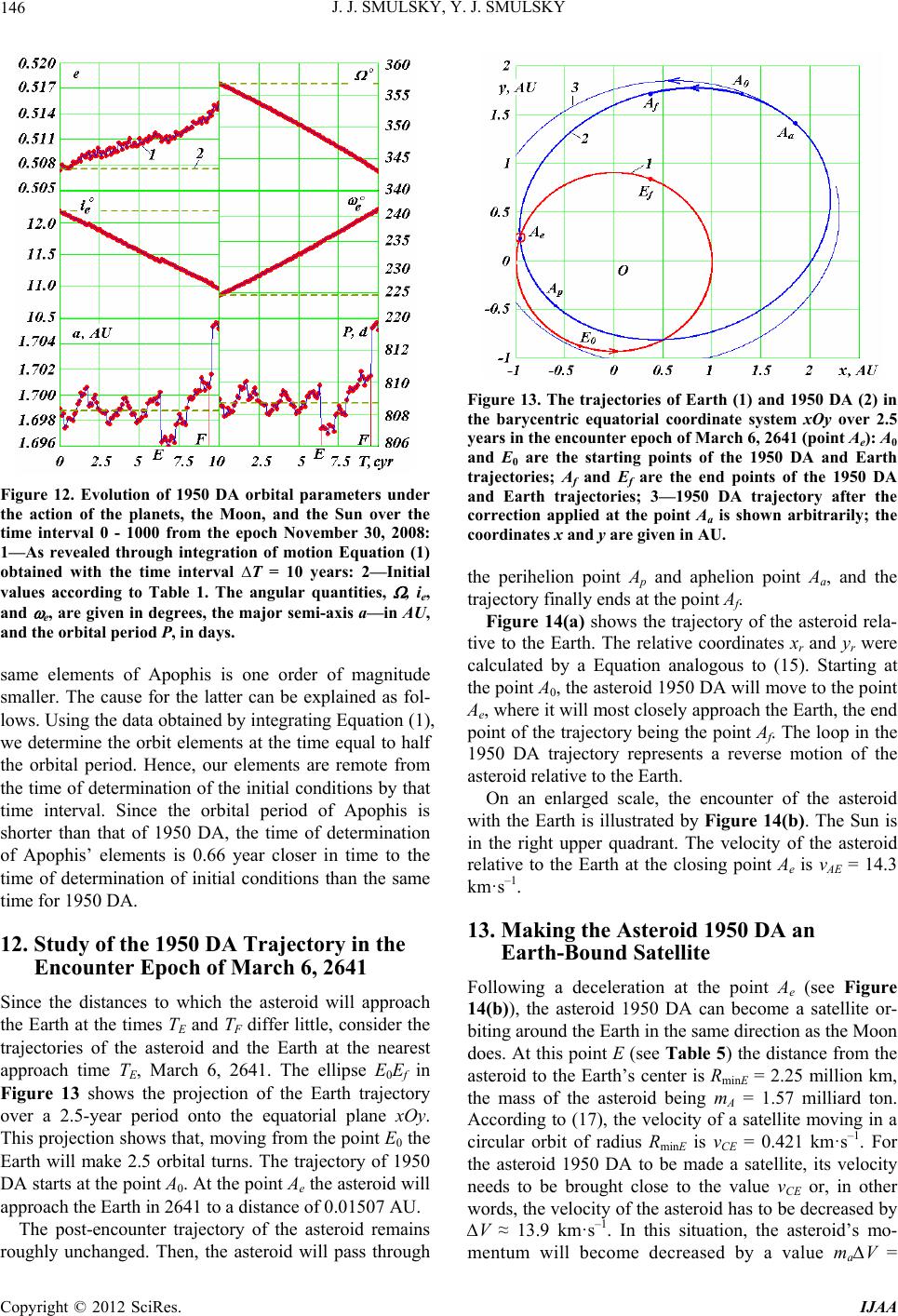 J. J. SMULSKY, Y. J. SMULSKY 146 Figure 12. Evolution of 1950 DA orbital parameters under the action of the planets, the Moon, and the Sun over the time interval 0 - 1000 from the epoch November 30, 2008: 1—As revealed through integration of motion Equation (1) obtained with the time interval ∆T = 10 years: 2—Initial values according to Table 1. The angular quantities, , ie, and e, are given in degrees, the major semi-axis a—in AU, and the orbital period P, in days. same elements of Apophis is one order of magnitude smaller. The cause for the latter can be explained as fol- lows. Using the data obtained by integrating Equation (1), we determine the orbit elements at the time equal to half the orbital period. Hence, our elements are remote from the time of determination of the initial conditions by that time interval. Since the orbital period of Apophis is shorter than that of 1950 DA, the time of determination of Apophis’ elements is 0.66 year closer in time to the time of determination of initial conditions than the same time for 1950 DA. 12. Study of the 1950 DA Trajectory in the Encounter Epoch of March 6, 2641 Since the distances to which the asteroid will approach the Earth at the times TE and TF differ little, consider the trajectories of the asteroid and the Earth at the nearest approach time TE, March 6, 2641. The ellipse E0Ef in Figure 13 shows the projection of the Earth trajectory over a 2.5-year period onto the equatorial plane xOy. This projection shows that, moving from the point E0 the Earth will make 2.5 orbital turns. The trajectory of 1950 DA starts at the point A0. At the point Ae the asteroid will approach the Earth in 2641 to a distance of 0.01507 AU. The post-encounter trajectory of the asteroid remains roughly unchanged. Then, the asteroid will pass through Figure 13. The trajectories of Earth (1) and 1950 DA (2) in the barycentric equatorial coordinate system xOy over 2.5 years in the encounter epoch of March 6, 2641 (point Ae): A0 and E0 are the starting points of the 1950 DA and Earth trajectories; Af and Ef are the end points of the 1950 DA and Earth trajectories; 3—1950 DA trajectory after the correction applied at the point Aa is shown arbitrarily; the coordinates x and y are given in AU. the perihelion point Ap and aphelion point Aa, and the trajectory finally ends at the point Af. Figure 14(a) shows the trajectory of the asteroid rela- tive to the Earth. The relative coordinates xr and yr were calculated by a Equation analogous to (15). Starting at the point A0, the asteroid 1950 DA will move to the point Ae, where it will most closely approach the Earth, the end point of the trajectory being the point Af. The loop in the 1950 DA trajectory represents a reverse motion of the asteroid relative to the Earth. On an enlarged scale, the encounter of the asteroid with the Earth is illustrated by Figure 14(b). The Sun is in the right upper quadrant. The velocity of the asteroid relative to the Earth at the closing point Ae is vAE = 14.3 km·s–1. 13. Making the Asteroid 1950 DA an Earth-Bound Satellite Following a deceleration at the point Ae (see Figure 14(b)), the asteroid 1950 DA can become a satellite or- biting around the Earth in the same direction as the Moon does. At this point E (see Table 5) the distance from the asteroid to the Earth’s center is RminE = 2.25 million km, the mass of the asteroid being mA = 1.57 milliard ton. According to (17), the velocity of a satellite moving in a circular orbit of radius RminE is vCE = 0.421 km·s–1. For the asteroid 1950 DA to be made a satellite, its velocity needs to be brought close to the value vCE or, in other words, the velocity of the asteroid has to be decreased by ∆V ≈ 13.9 km·s–1. In this situation, the asteroid’s mo- mentum will become decreased by a value ma∆V = Copyright © 2012 SciRes. IJAA 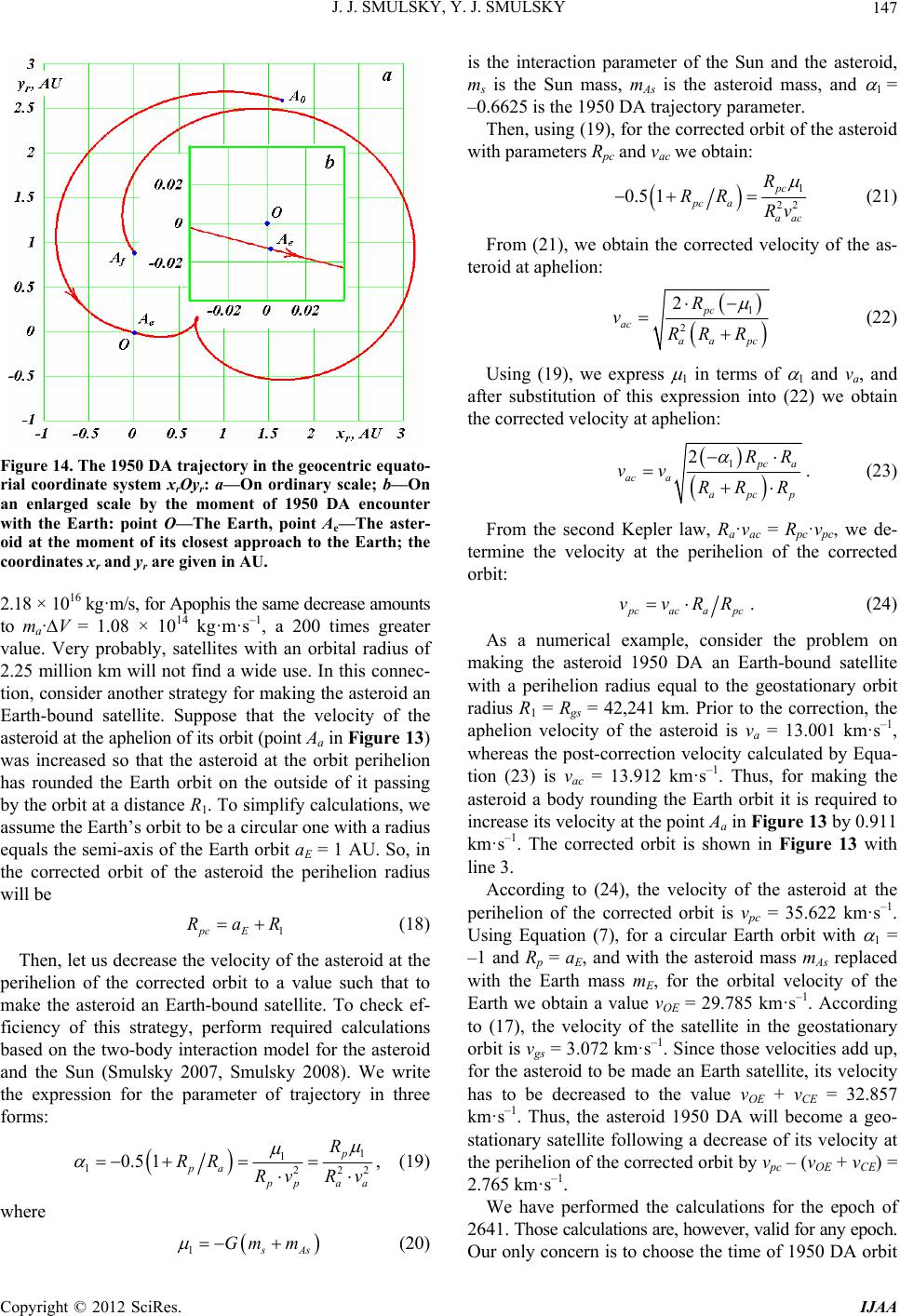 J. J. SMULSKY, Y. J. SMULSKY 147 Figure 14. The 1950 DA trajectory in the geocentric equato- rial coordinate system xrOyr: a—On ordinary scale; b—On an enlarged scale by the moment of 1950 DA encounter with the Earth: point O—The Earth, point Ae—The aster- oid at the moment of its closest approach to the Earth; the coordinates xr and yr are given in AU. 2.18 × 1016 kg·m/s, for Apophis the same decrease amounts to ma·∆V = 1.08 × 1014 kg·m·s–1, a 200 times greater value. Very probably, satellites with an orbital radius of 2.25 million km will not find a wide use. In this connec- tion, consider another strategy for making the asteroid an Earth-bound satellite. Suppose that the velocity of the asteroid at the aphelion of its orbit (point Aa in Figure 13) was increased so that the asteroid at the orbit perihelion has rounded the Earth orbit on the outside of it passing by the orbit at a distance R1. To simplify calculations, we assume the Earth’s orbit to be a circular one with a radius equals the semi-axis of the Earth orbit aE = 1 AU. So, in the corrected orbit of the asteroid the perihelion radius will be 1pcE RaR (18) Then, let us decrease the velocity of the asteroid at the perihelion of the corrected orbit to a value such that to make the asteroid an Earth-bound satellite. To check ef- ficiency of this strategy, perform required calculations based on the two-body interaction model for the asteroid and the Sun (Smulsky 2007, Smulsky 2008). We write the expression for the parameter of trajectory in three forms: 1 1 122 0.5 1p pa 2 pa R RR Rv Rv a , (19) where 1 is the interaction parameter of the Sun and the asteroid, ms is the Sun mass, mAs is the asteroid mass, and = –0.6625 is the 1950 DA trajectory parameter. Then, using (19), for the corrected orbit of the asteroid with parameters Rpc and vac we obtain: 1 22 0.5 1pc pc a aac R RR Rv (21) From (21), we obtain the corrected velocity of the as- teroid at aphelion: 1 2 2pc ac aa pc R vRR R (22) Using (19), we express in terms of 1 and va, and after substitution of this expression into (22) we obtain the corrected velocity at aphelion: 1 2 ca ac a apcp RR vvRR R . (23) From the second Kepler law, Ra·vac = Rpc·vpc, we de- termine the velocity at the perihelion of the corrected orbit: cacap vvRR c . (24) As a numerical example, consider the problem on making the asteroid 1950 DA an Earth-bound satellite with a perihelion radius equal to the geostationary orbit radius R1 = Rgs = 42,241 km. Prior to the correction, the aphelion velocity of the asteroid is va = 13.001 km·s–1, whereas the post-correction velocity calculated by Equa- tion (23) is vac = 13.912 km·s–1. Thus, for making the asteroid a body rounding the Earth orbit it is required to increase its velocity at the point Aa in Figure 13 by 0.911 km·s–1. The corrected orbit is shown in Figure 13 with line 3. According to (24), the velocity of the asteroid at the perihelion of the corrected orbit is vpc = 35.622 km·s–1. Using Equation (7), for a circular Earth orbit with = –1 and Rp = aE, and with the asteroid mass mAs replaced with the Earth mass mE, for the orbital velocity of the Earth we obtain a value vOE = 29.785 km·s–1. According to (17), the velocity of the satellite in the geostationary orbit is vgs = 3.072 km·s–1. Since those velocities add up, for the asteroid to be made an Earth satellite, its velocity has to be decreased to the value vOE + vCE = 32.857 km·s–1. Thus, the asteroid 1950 DA will become a geo- stationary satellite following a decrease of its velocity at the perihelion of the corrected orbit by vpc – (vOE + vCE) = 2.765 km·s–1. We have performed the calculations for the epoch of 2641. Those calculations are, however, valid for any epoch. Our only concern is to choose the time of 1950 DA orbit As Gm m (20) Copyright © 2012 SciRes. IJAA 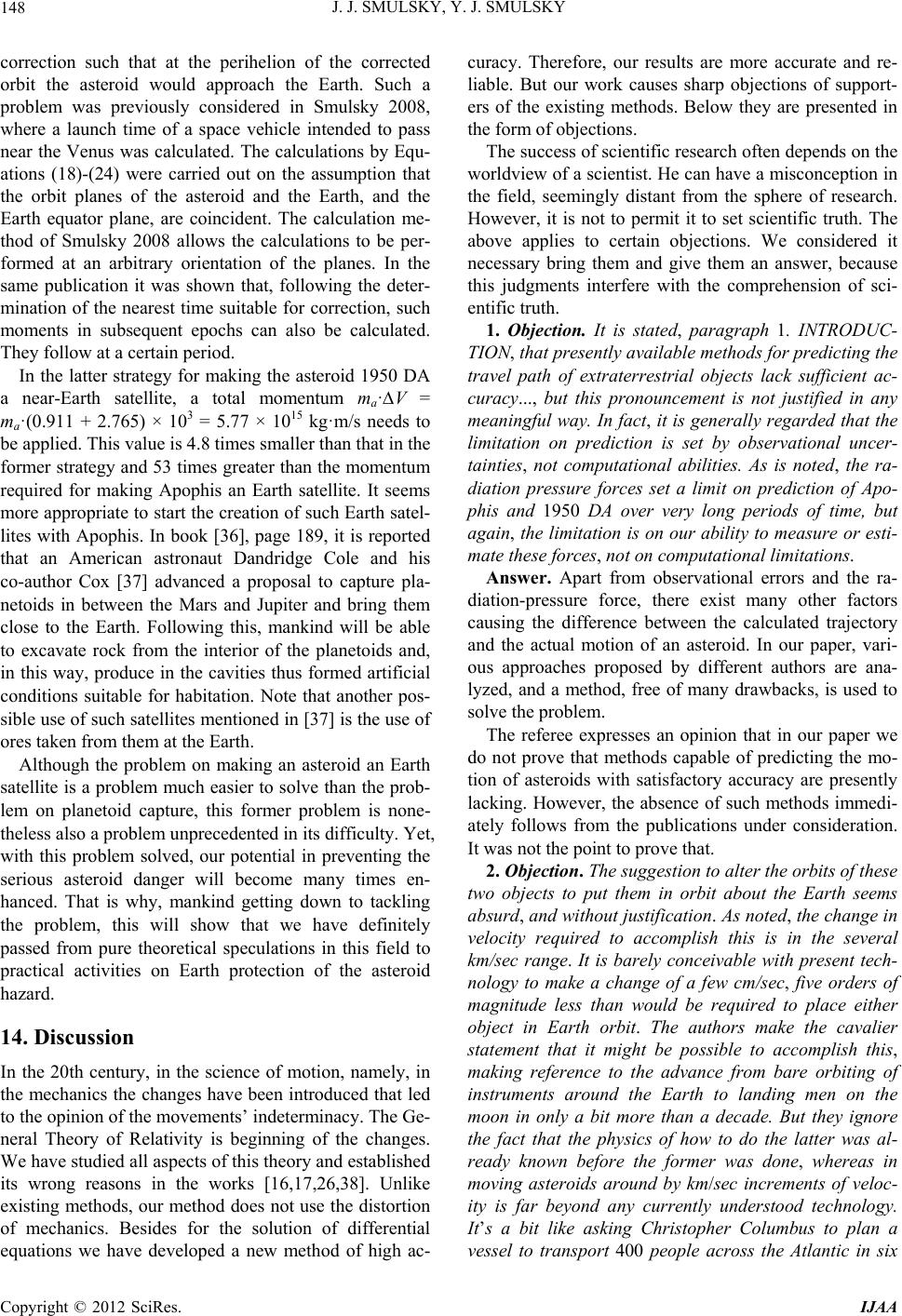 J. J. SMULSKY, Y. J. SMULSKY 148 correction such that at the perihelion of the corrected orbit the asteroid would approach the Earth. Such a problem was previously considered in Smulsky 2008, where a launch time of a space vehicle intended to pass near the Venus was calculated. The calculations by Equ- ations (18)-(24) were carried out on the assumption that the orbit planes of the asteroid and the Earth, and the Earth equator plane, are coincident. The calculation me- thod of Smulsky 2008 allows the calculations to be per- formed at an arbitrary orientation of the planes. In the same publication it was shown that, following the deter- mination of the nearest time suitable for correction, such moments in subsequent epochs can also be calculated. They follow at a certain period. In the latter strategy for making the asteroid 1950 DA a near-Earth satellite, a total momentum ma·∆V = ma·(0.911 + 2.765) × 103 = 5.77 × 1015 kg·m/s needs to be applied. This value is 4.8 times smaller than that in the former strategy and 53 times greater than the momentum required for making Apophis an Earth satellite. It seems more appropriate to start the creation of such Earth satel- lites with Apophis. In book [36], page 189, it is reported that an American astronaut Dandridge Cole and his co-author Cox [37] advanced a proposal to capture pla- netoids in between the Mars and Jupiter and bring them close to the Earth. Following this, mankind will be able to excavate rock from the interior of the planetoids and, in this way, produce in the cavities thus formed artificial conditions suitable for habitation. Note that another pos- sible use of such satellites mentioned in [37] is the use of ores taken from them at the Earth. Although the problem on making an asteroid an Earth satellite is a problem much easier to solve than the prob- lem on planetoid capture, this former problem is none- theless also a problem unprecedented in its difficulty. Yet, with this problem solved, our potential in preventing the serious asteroid danger will become many times en- hanced. That is why, mankind getting down to tackling the problem, this will show that we have definitely passed from pure theoretical speculations in this field to practical activities on Earth protection of the asteroid hazard. 14. Discussion In the 20th century, in the science of motion, namely, in the mechanics the changes have been introduced that led to the opinion of the movements’ indeterminacy. The Ge- neral Theory of Relativity is beginning of the changes. We have studied all aspects of this theory and established its wrong reasons in the works [16,17,26,38]. Unlike existing methods, our method does not use the distortion of mechanics. Besides for the solution of differential equations we have developed a new method of high ac- curacy. Therefore, our results are more accurate and re- liable. But our work causes sharp objections of support- ers of the existing methods. Below they are presented in the form of objections. The success of scientific research often depends on the worldview of a scientist. He can have a misconception in the field, seemingly distant from the sphere of research. However, it is not to permit it to set scientific truth. The above applies to certain objections. We considered it necessary bring them and give them an answer, because this judgments interfere with the comprehension of sci- entific truth. 1. Objection. It is stated, paragraph 1. INTRODUC- TION, that presently available methods for predicting the travel path of extraterrestrial objects lack sufficient ac- curacy..., but this pronouncement is not justified in any meaningful way. In fact, it is generally regarded that the limitation on prediction is set by observational uncer- tainties, not computational abilities. As is noted, the ra- diation pressure forces set a limit on prediction of Apo- phis and 1950 DA over very long periods of time, but again, the limitation is on our ability to measure or esti- mate these forces, not on computational limitations. Answer. Apart from observational errors and the ra- diation-pressure force, there exist many other factors causing the difference between the calculated trajectory and the actual motion of an asteroid. In our paper, vari- ous approaches proposed by different authors are ana- lyzed, and a method, free of many drawbacks, is used to solve the problem. The referee expresses an opinion that in our paper we do not prove that methods capable of predicting the mo- tion of asteroids with satisfactory accuracy are presently lacking. However, the absence of such methods immedi- ately follows from the publications under consideration. It was not the point to prove that. 2. Objection. The suggestion to alter the orbits of these two objects to put them in orbit about the Earth seems absurd, and without justification. As noted, the change in velocity required to accomplish this is in the several km/sec range. It is barely conceivable with present tech- nology to make a change of a few cm/sec, five orders of magnitude less than would be required to place either object in Earth orbit. The authors make the cavalier statement that it might be possible to accomplish this, making reference to the advance from bare orbiting of instruments around the Earth to landing men on the moon in only a bit more than a decade. But they ignore the fact that the physics of how to do the latter was al- ready known before the former was done, whereas in moving asteroids around by km/sec increments of veloc- ity is far beyond any currently understood technology. It’s a bit like asking Christopher Columbus to plan a vessel to transport 400 people across the Atlantic in six Copyright © 2012 SciRes. IJAA 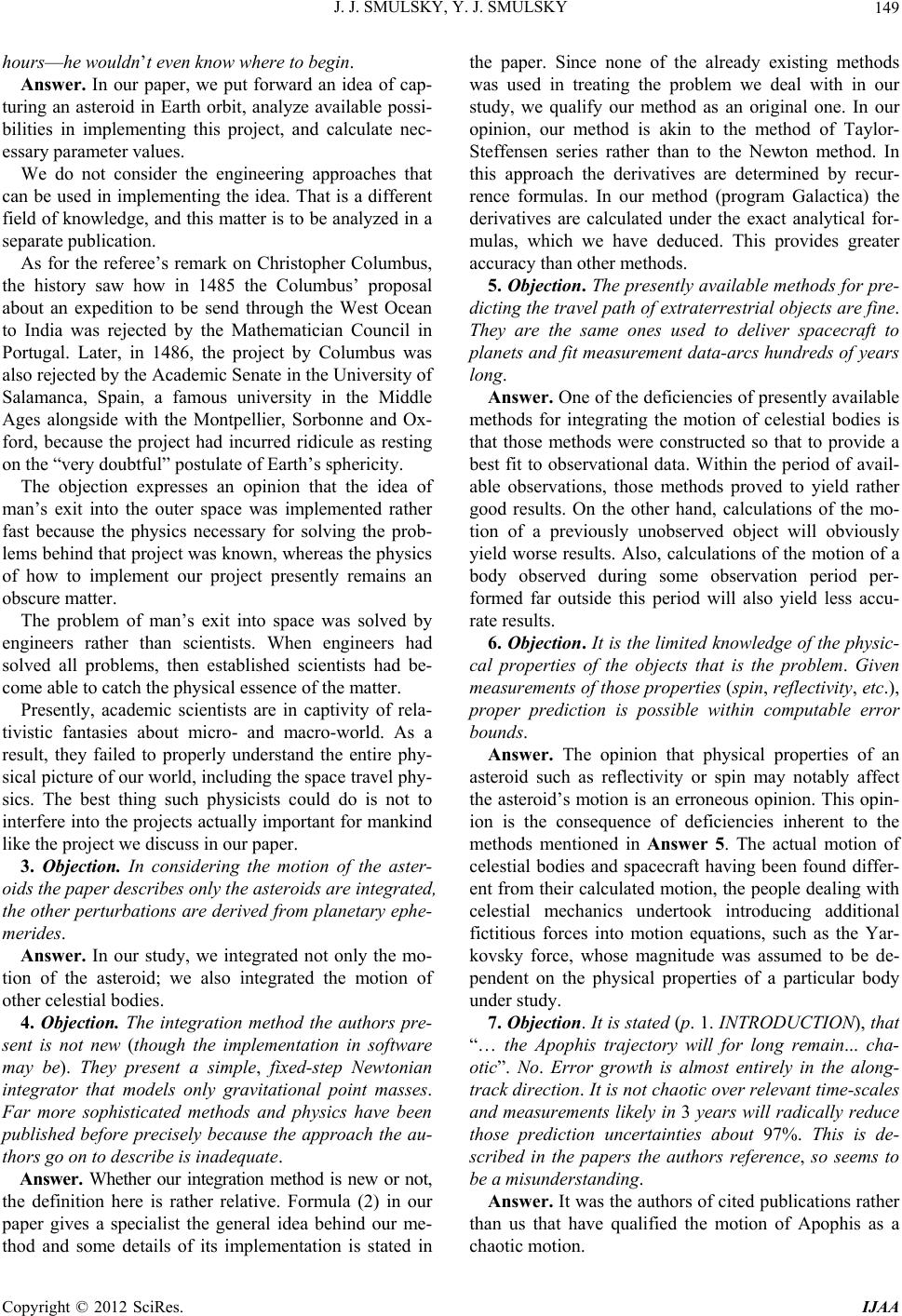 J. J. SMULSKY, Y. J. SMULSKY 149 hours—he wouldn’t even know where to begin. Answer. In our paper, we put forward an idea of cap- turing an asteroid in Earth orbit, analyze available possi- bilities in implementing this project, and calculate nec- essary parameter values. We do not consider the engineering approaches that can be used in implementing the idea. That is a different field of knowledge, and this matter is to be analyzed in a separate publication. As for the referee’s remark on Christopher Columbus, the history saw how in 1485 the Columbus’ proposal about an expedition to be send through the West Ocean to India was rejected by the Mathematician Council in Portugal. Later, in 1486, the project by Columbus was also rejected by the Academic Senate in the University of Salamanca, Spain, a famous university in the Middle Ages alongside with the Montpellier, Sorbonne and Ox- ford, because the project had incurred ridicule as resting on the “very doubtful” postulate of Earth’s sphericity. The objection expresses an opinion that the idea of man’s exit into the outer space was implemented rather fast because the physics necessary for solving the prob- lems behind that project was known, whereas the physics of how to implement our project presently remains an obscure matter. The problem of man’s exit into space was solved by engineers rather than scientists. When engineers had solved all problems, then established scientists had be- come able to catch the physical essence of the matter. Presently, academic scientists are in captivity of rela- tivistic fantasies about micro- and macro-world. As a result, they failed to properly understand the entire phy- sical picture of our world, including the space travel phy- sics. The best thing such physicists could do is not to interfere into the projects actually important for mankind like the project we discuss in our paper. 3. Objection. In considering the motion of the aster- oids the paper describes only the asteroids are integrated, the other perturbations are derived from planetary ephe- merides. Answer. In our study, we integrated not only the mo- tion of the asteroid; we also integrated the motion of other celestial bodies. 4. Objection. The integration method the authors pre- sent is not new (though the implementation in software may be). They present a simple, fixed-step Newtonian integrator that models only gravitational point masses. Far more sophisticated methods and physics have been published before precisely because the approach the au- thors go on to describe is inadequate. Answer. Whether our integration method is new or not, the definition here is rather relative. Formula (2) in our paper gives a specialist the general idea behind our me- thod and some details of its implementation is stated in the paper. Since none of the already existing methods was used in treating the problem we deal with in our study, we qualify our method as an original one. In our opinion, our method is akin to the method of Taylor- Steffensen series rather than to the Newton method. In this approach the derivatives are determined by recur- rence formulas. In our method (program Galactica) the derivatives are calculated under the exact analytical for- mulas, which we have deduced. This provides greater accuracy than other methods. 5. Objection. The presently available methods for pre- dicting the travel path of extraterrestrial objects are fine. They are the same ones used to deliver spacecraft to planets and fit measurement data-arcs hundreds of years long. Answer. One of the deficiencies of presently available methods for integrating the motion of celestial bodies is that those methods were constructed so that to provide a best fit to observational data. Within the period of avail- able observations, those methods proved to yield rather good results. On the other hand, calculations of the mo- tion of a previously unobserved object will obviously yield worse results. Also, calculations of the motion of a body observed during some observation period per- formed far outside this period will also yield less accu- rate results. 6. Objection. It is the limited knowledge of the physic- cal properties of the objects that is the problem. Given measurements of those properties (spin, reflectivity, etc.), proper prediction is possible within computable error bounds. Answer. The opinion that physical properties of an asteroid such as reflectivity or spin may notably affect the asteroid’s motion is an erroneous opinion. This opin- ion is the consequence of deficiencies inherent to the methods mentioned in Answer 5. The actual motion of celestial bodies and spacecraft having been found differ- ent from their calculated motion, the people dealing with celestial mechanics undertook introducing additional fictitious forces into motion equations, such as the Yar- kovsky force, whose magnitude was assumed to be de- pendent on the physical properties of a particular body under study. 7. Objection. It is stated (p. 1. INTRODUCTION), that “… the Apophis trajectory will for long remain... cha- otic”. No. Error growth is almost entirely in the along- track direction. It is not chaotic over relevant time-scales and measurements likely in 3 years will radically reduce those prediction uncertainties about 97%. This is de- scribed in the papers the authors reference, so seems to be a misunderstanding. Answer. It was the authors of cited publications rather than us that have qualified the motion of Apophis as a chaotic motion. Copyright © 2012 SciRes. IJAA 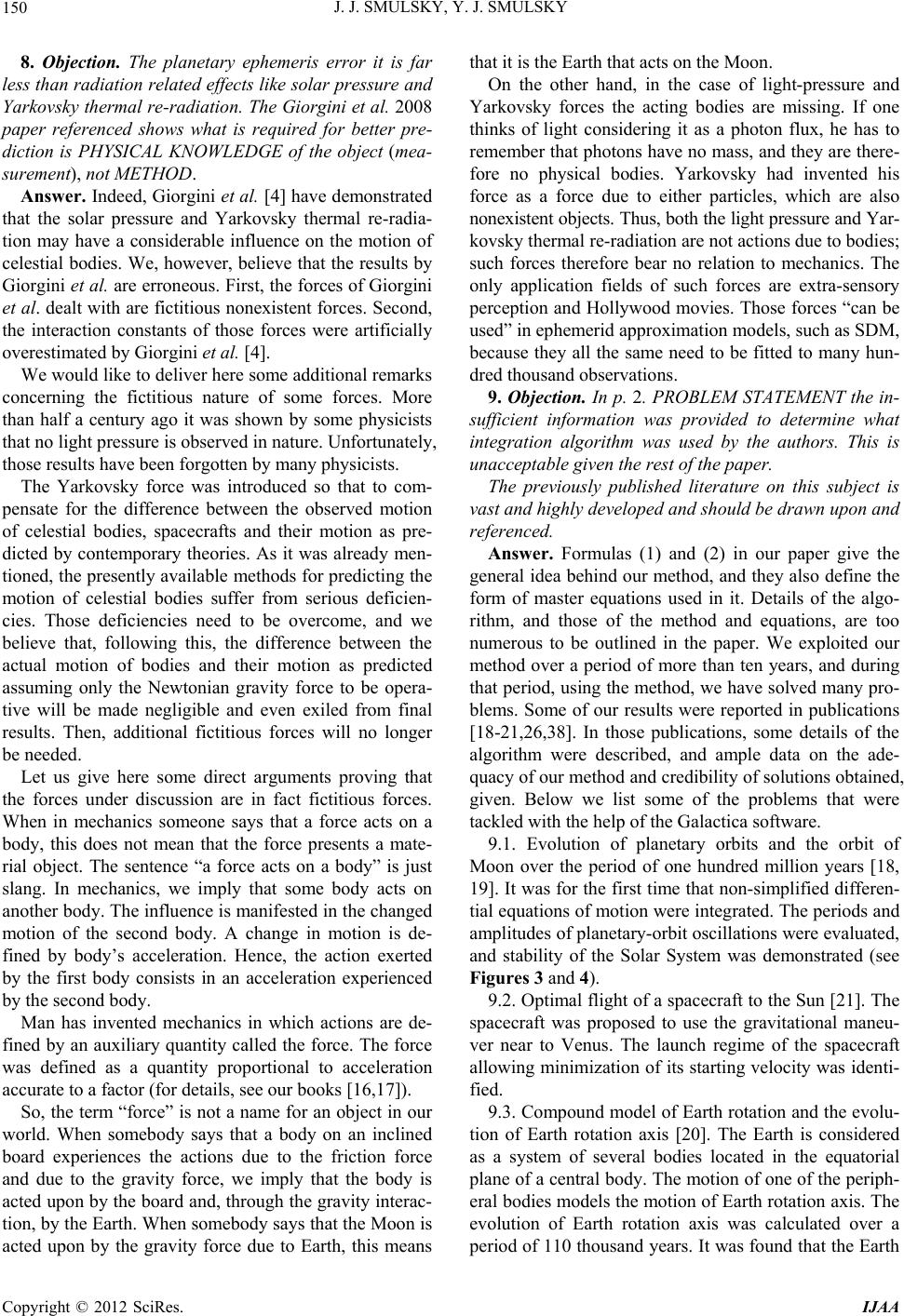 J. J. SMULSKY, Y. J. SMULSKY 150 8. Objectio n. The planetary ephemeris error it is far less than radiation related effects like solar pressure and Yarkovsky thermal re-radiation. The Giorgini et al. 2008 paper referenced shows what is required for better pre- diction is PHYSICAL KNOWLEDGE of the object (mea- surement), not METHOD. Answer. Indeed, Giorgini et al. [4] have demonstrated that the solar pressure and Yarkovsky thermal re-radia- tion may have a considerable influence on the motion of celestial bodies. We, however, believe that the results by Giorgini et al. are erroneous. First, the forces of Giorgini et al. dealt with are fictitious nonexistent forces. Second, the interaction constants of those forces were artificially overestimated by Giorgini et al. [4]. We would like to deliver here some additional remarks concerning the fictitious nature of some forces. More than half a century ago it was shown by some physicists that no light pressure is observed in nature. Unfortunately, those results have been forgotten by many physicists. The Yarkovsky force was introduced so that to com- pensate for the difference between the observed motion of celestial bodies, spacecrafts and their motion as pre- dicted by contemporary theories. As it was already men- tioned, the presently available methods for predicting the motion of celestial bodies suffer from serious deficien- cies. Those deficiencies need to be overcome, and we believe that, following this, the difference between the actual motion of bodies and their motion as predicted assuming only the Newtonian gravity force to be opera- tive will be made negligible and even exiled from final results. Then, additional fictitious forces will no longer be needed. Let us give here some direct arguments proving that the forces under discussion are in fact fictitious forces. When in mechanics someone says that a force acts on a body, this does not mean that the force presents a mate- rial object. The sentence “a force acts on a body” is just slang. In mechanics, we imply that some body acts on another body. The influence is manifested in the changed motion of the second body. A change in motion is de- fined by body’s acceleration. Hence, the action exerted by the first body consists in an acceleration experienced by the second body. Man has invented mechanics in which actions are de- fined by an auxiliary quantity called the force. The force was defined as a quantity proportional to acceleration accurate to a factor (for details, see our books [16,17]). So, the term “force” is not a name for an object in our world. When somebody says that a body on an inclined board experiences the actions due to the friction force and due to the gravity force, we imply that the body is acted upon by the board and, through the gravity interac- tion, by the Earth. When somebody says that the Moon is acted upon by the gravity force due to Earth, this means that it is the Earth that acts on the Moon. On the other hand, in the case of light-pressure and Yarkovsky forces the acting bodies are missing. If one thinks of light considering it as a photon flux, he has to remember that photons have no mass, and they are there- fore no physical bodies. Yarkovsky had invented his force as a force due to either particles, which are also nonexistent objects. Thus, both the light pressure and Yar- kovsky thermal re-radiation are not actions due to bodies; such forces therefore bear no relation to mechanics. The only application fields of such forces are extra-sensory perception and Hollywood movies. Those forces “can be used” in ephemerid approximation models, such as SDM, because they all the same need to be fitted to many hun- dred thousand observations. 9. Objection. In p. 2. PROBLEM STATEMENT the in- sufficient information was provided to determine what integration algorithm was used by the authors. This is unacceptable given the rest of the paper. The previously published literature on this subject is vast and highly developed and should be drawn upon and referenced. Answer. Formulas (1) and (2) in our paper give the general idea behind our method, and they also define the form of master equations used in it. Details of the algo- rithm, and those of the method and equations, are too numerous to be outlined in the paper. We exploited our method over a period of more than ten years, and during that period, using the method, we have solved many pro- blems. Some of our results were reported in publications [18-21,26,38]. In those publications, some details of the algorithm were described, and ample data on the ade- quacy of our method and credibility of solutions obtained, given. Below we list some of the problems that were tackled with the help of the Galactica software. 9.1. Evolution of planetary orbits and the orbit of Moon over the period of one hundred million years [18, 19]. It was for the first time that non-simplified differen- tial equations of motion were integrated. The periods and amplitudes of planetary-orbit oscillations were evaluated, and stability of the Solar System was demonstrated (see Figures 3 and 4). 9.2. Optimal flight of a spacecraft to the Sun [21]. The spacecraft was proposed to use the gravitational maneu- ver near to Venus. The launch regime of the spacecraft allowing minimization of its starting velocity was identi- fied. 9.3. Compound model of Earth rotation and the evolu- tion of Earth rotation axis [20]. The Earth is considered as a system of several bodies located in the equatorial plane of a central body. The motion of one of the periph- eral bodies models the motion of Earth rotation axis. The evolution of Earth rotation axis was calculated over a period of 110 thousand years. It was found that the Earth Copyright © 2012 SciRes. IJAA 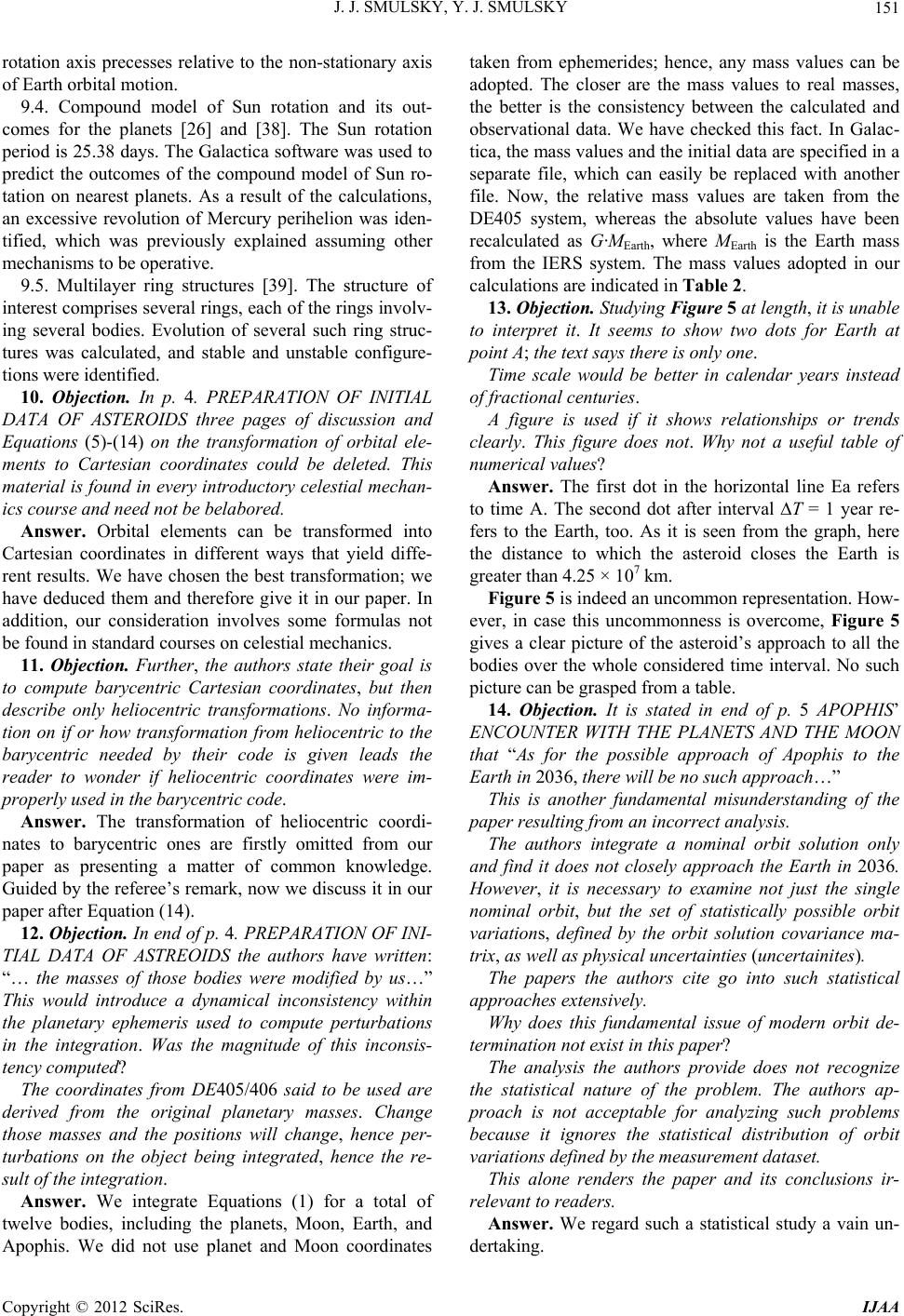 J. J. SMULSKY, Y. J. SMULSKY 151 rotation axis precesses relative to the non-stationary axis of Earth orbital motion. 9.4. Compound model of Sun rotation and its out- comes for the planets [26] and [38]. The Sun rotation period is 25.38 days. The Galactica software was used to predict the outcomes of the compound model of Sun ro- tation on nearest planets. As a result of the calculations, an excessive revolution of Mercury perihelion was iden- tified, which was previously explained assuming other mechanisms to be operative. 9.5. Multilayer ring structures [39]. The structure of interest comprises several rings, each of the rings involv- ing several bodies. Evolution of several such ring struc- tures was calculated, and stable and unstable configure- tions were identified. 10. Objectio n. In p. 4. PREPARATION OF INITIAL DATA OF ASTEROIDS three pages of discussion and Equations (5)-(14) on the transformation of orbital ele- ments to Cartesian coordinates could be deleted. This material is found in every introductory celestial mechan- ics course and need not be belabored. Answer. Orbital elements can be transformed into Cartesian coordinates in different ways that yield diffe- rent results. We have chosen the best transformation; we have deduced them and therefore give it in our paper. In addition, our consideration involves some formulas not be found in standard courses on celestial mechanics. 11. Objection. Further, the authors state their goal is to compute barycentric Cartesian coordinates, but then describe only heliocentric transformations. No informa- tion on if or how transformation from heliocentric to the barycentric needed by their code is given leads the reader to wonder if heliocentric coordinates were im- properly used in the barycentric code. Answer. The transformation of heliocentric coordi- nates to barycentric ones are firstly omitted from our paper as presenting a matter of common knowledge. Guided by the referee’s remark, now we discuss it in our paper after Equation (14). 12. Objection. In end of p. 4. PREPARATION OF INI- TIAL DATA OF ASTREOIDS the authors have written: “… the masses of those bodies were modified by us…” This would introduce a dynamical inconsistency within the planetary ephemeris used to compute perturbations in the integration. Was the magnitude of this inconsis- tency computed? The coordinates from DE405/406 said to be used are derived from the original planetary masses. Change those masses and the positions will change, hence per- turbations on the object being integrated, hence the re- sult of the integration. Answer. We integrate Equations (1) for a total of twelve bodies, including the planets, Moon, Earth, and Apophis. We did not use planet and Moon coordinates taken from ephemerides; hence, any mass values can be adopted. The closer are the mass values to real masses, the better is the consistency between the calculated and observational data. We have checked this fact. In Galac- tica, the mass values and the initial data are specified in a separate file, which can easily be replaced with another file. Now, the relative mass values are taken from the DE405 system, whereas the absolute values have been recalculated as G·MEarth, where MEarth is the Earth mass from the IERS system. The mass values adopted in our calculations are indicated in Table 2. 13. Objection. Studying Figure 5 at length, it is unable to interpret it. It seems to show two dots for Earth at point A; the text says there is only one. Time scale would be better in calendar years instead of fractional centuries. A figure is used if it shows relationships or trends clearly. This figure does not. Why not a useful table of numerical values? Answer. The first dot in the horizontal line Ea refers to time А. The second dot after interval Т = 1 year re- fers to the Earth, too. As it is seen from the graph, here the distance to which the asteroid closes the Earth is greater than 4.25 × 107 km. Figure 5 is indeed an uncommon representation. How- ever, in case this uncommonness is overcome, Figure 5 gives a clear picture of the asteroid’s approach to all the bodies over the whole considered time interval. No such picture can be grasped from a table. 14. Objection. It is stated in end of p. 5 APOPHIS’ ENCOUNTER WITH THE PLANETS AND THE MOON that “As for the possible approach of Apophis to the Earth in 2036, there will be no such approach…” This is another fundamental misunderstanding of the paper resulting from an incorrect analysis. The authors integrate a nominal orbit solution only and find it does not closely approach the Earth in 2036. However, it is necessary to examine not just the single nominal orbit, but the set of statistically possible orbit variations, defined by the orbit solution covariance ma- trix, as well as physical uncertainties (uncertainites). The papers the authors cite go into such statistical approaches extensively. Why does this fundamental issue of modern orbit de- termination not exist in this paper? The analysis the authors provide does not recognize the statistical nature of the problem. The authors ap- proach is not acceptable for analyzing such problems because it ignores the statistical distribution of orbit variations defined by the measurement dataset. This alone renders the paper and its conclusions ir- relevant to readers. Answer. We regard such a statistical study a vain un- dertaking. Copyright © 2012 SciRes. IJAA 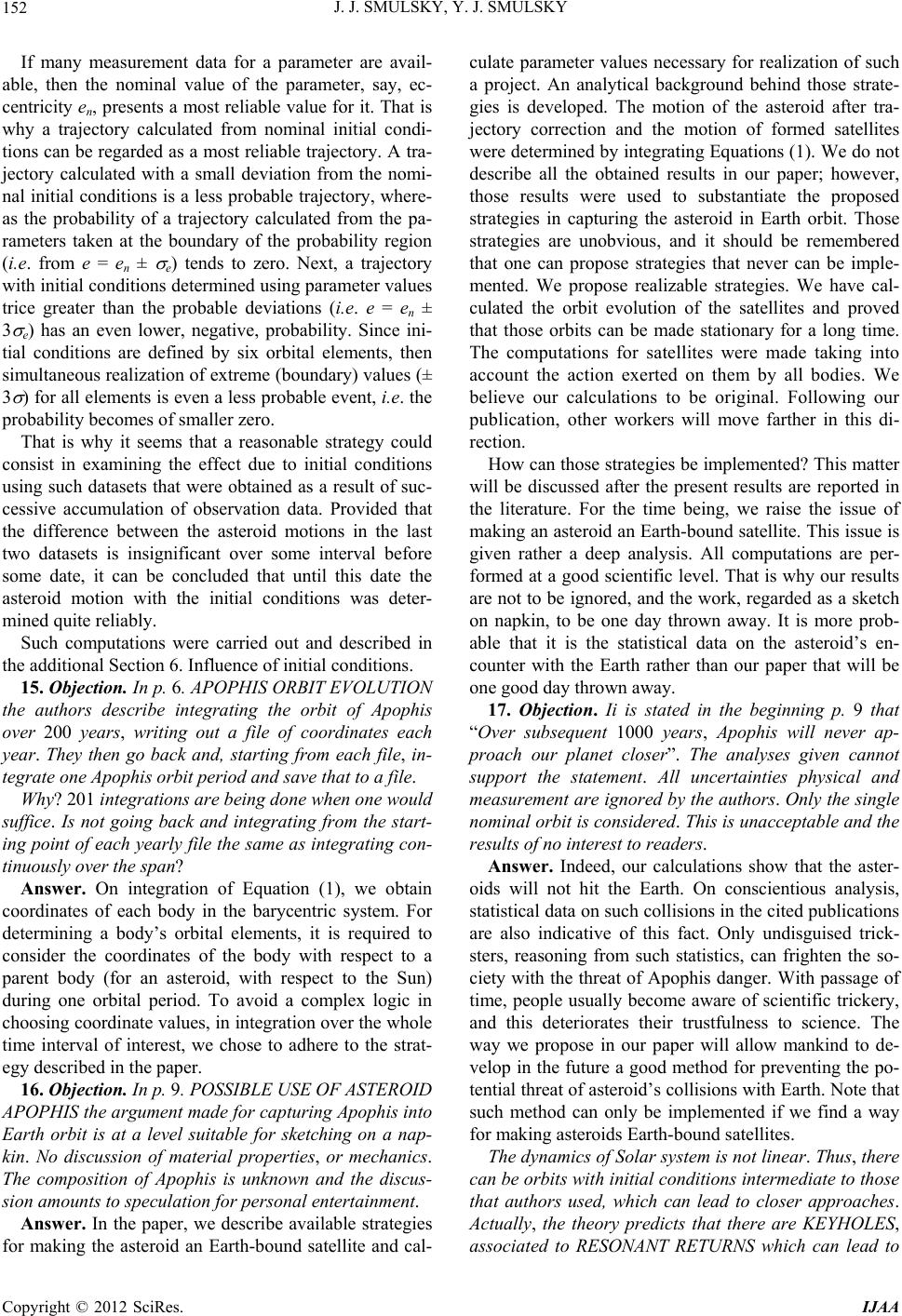 J. J. SMULSKY, Y. J. SMULSKY 152 If many measurement data for a parameter are avail- able, then the nominal value of the parameter, say, ec- centricity en, presents a most reliable value for it. That is why a trajectory calculated from nominal initial condi- tions can be regarded as a most reliable trajectory. A tra- jectory calculated with a small deviation from the nomi- nal initial conditions is a less probable trajectory, where- as the probability of a trajectory calculated from the pa- rameters taken at the boundary of the probability region (i.e. from e = en ± e) tends to zero. Next, a trajectory with initial conditions determined using parameter values trice greater than the probable deviations (i.e. e = en ± 3 e) has an even lower, negative, probability. Since ini- tial conditions are defined by six orbital elements, then simultaneous realization of extreme (boundary) values (± 3 ) for all elements is even a less probable event, i.e. the probability becomes of smaller zero. That is why it seems that a reasonable strategy could consist in examining the effect due to initial conditions using such datasets that were obtained as a result of suc- cessive accumulation of observation data. Provided that the difference between the asteroid motions in the last two datasets is insignificant over some interval before some date, it can be concluded that until this date the asteroid motion with the initial conditions was deter- mined quite reliably. Such computations were carried out and described in the additional Section 6. Influence of initial conditions. 15. Objection. In p. 6. APOPHIS ORBIT EVOLUTION the authors describe integrating the orbit of Apophis over 200 years, writing out a file of coordinates each year. They then go back and, starting from each file, in- tegrate one Apophis orbit period and save that to a file. Why? 201 integrations are being done when one would suffice. Is not going back and integrating from the start- ing point of each yearly file the same as integrating con- tinuously over the span? Answer. On integration of Equation (1), we obtain coordinates of each body in the barycentric system. For determining a body’s orbital elements, it is required to consider the coordinates of the body with respect to a parent body (for an asteroid, with respect to the Sun) during one orbital period. To avoid a complex logic in choosing coordinate values, in integration over the whole time interval of interest, we chose to adhere to the strat- egy described in the paper. 16. Objection. In p. 9. POSSIBLE USE OF ASTEROID APOPHIS the argument made for capturing Apophis into Earth orbit is at a level suitable for sketching on a nap- kin. No discussion of material properties, or mechanics. The composition of Apophis is unknown and the discus- sion amounts to speculation for personal entertainment. Answer. In the paper, we describe available strategies for making the asteroid an Earth-bound satellite and cal- culate parameter values necessary for realization of such a project. An analytical background behind those strate- gies is developed. The motion of the asteroid after tra- jectory correction and the motion of formed satellites were determined by integrating Equations (1). We do not describe all the obtained results in our paper; however, those results were used to substantiate the proposed strategies in capturing the asteroid in Earth orbit. Those strategies are unobvious, and it should be remembered that one can propose strategies that never can be imple- mented. We propose realizable strategies. We have cal- culated the orbit evolution of the satellites and proved that those orbits can be made stationary for a long time. The computations for satellites were made taking into account the action exerted on them by all bodies. We believe our calculations to be original. Following our publication, other workers will move farther in this di- rection. How can those strategies be implemented? This matter will be discussed after the present results are reported in the literature. For the time being, we raise the issue of making an asteroid an Earth-bound satellite. This issue is given rather a deep analysis. All computations are per- formed at a good scientific level. That is why our results are not to be ignored, and the work, regarded as a sketch on napkin, to be one day thrown away. It is more prob- able that it is the statistical data on the asteroid’s en- counter with the Earth rather than our paper that will be one good day thrown away. 17. Objection. Ii is stated in the beginning p. 9 that “Over subsequent 1000 years, Apophis will never ap- proach our planet closer”. The analyses given cannot support the statement. All uncertainties physical and measurement are ignored by the authors. Only the single nominal orbit is considered. This is unacceptable and the results of no interest to readers. Answer. Indeed, our calculations show that the aster- oids will not hit the Earth. On conscientious analysis, statistical data on such collisions in the cited publications are also indicative of this fact. Only undisguised trick- sters, reasoning from such statistics, can frighten the so- ciety with the threat of Apophis danger. With passage of time, people usually become aware of scientific trickery, and this deteriorates their trustfulness to science. The way we propose in our paper will allow mankind to de- velop in the future a good method for preventing the po- tential threat of asteroid’s collisions with Earth. Note that such method can only be implemented if we find a way for making asteroids Earth-bound satellites. The dynamics of Solar system is not linear. Thus, there can be orbits with initial conditions intermediate to those that authors used, which can lead to closer approaches. Actually, the theory predicts that there are KEYHOLES, associated to RESONANT RETURNS which can lead to Copyright © 2012 SciRes. IJAA 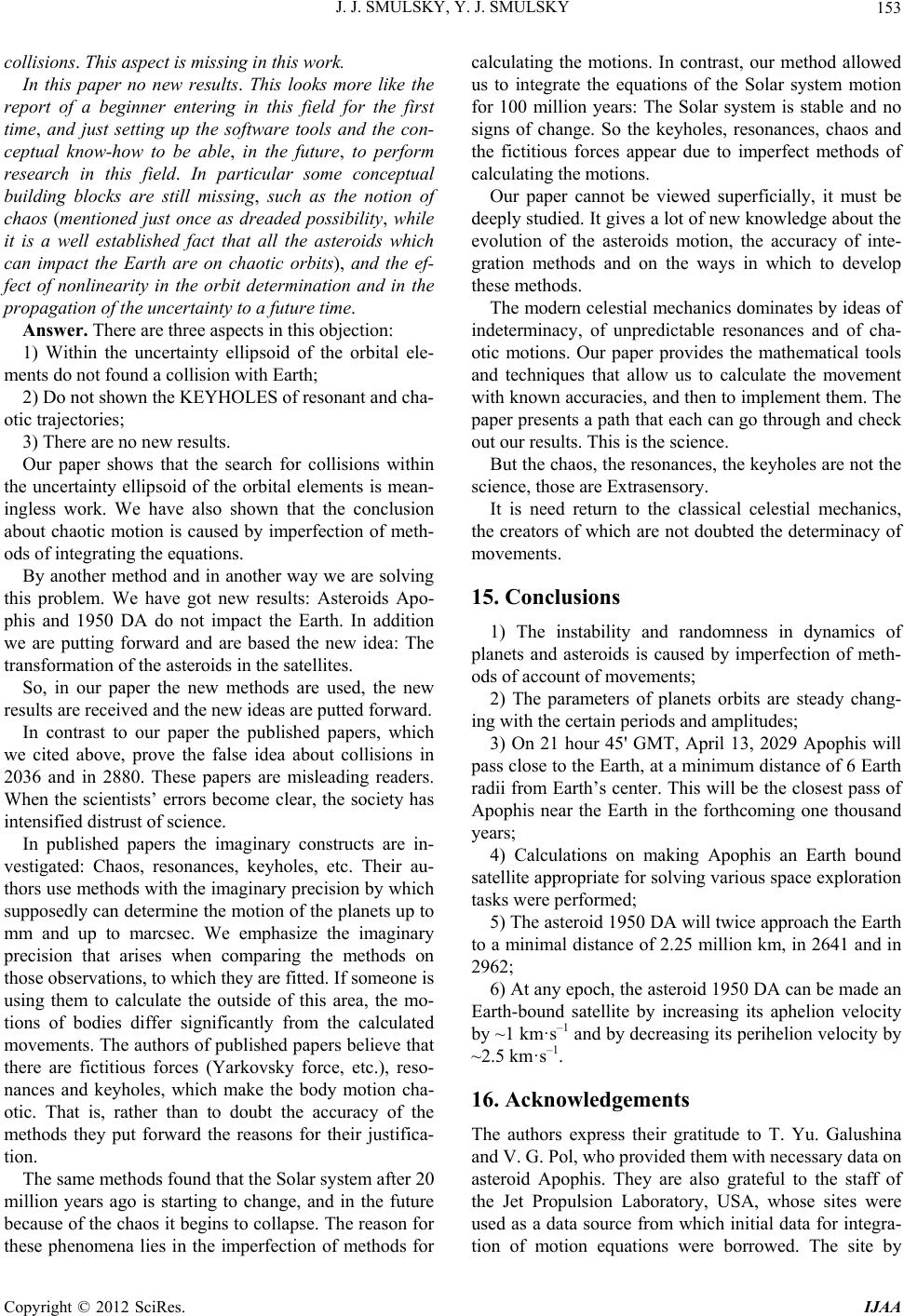 J. J. SMULSKY, Y. J. SMULSKY 153 collisions. This aspect is missing in this work. In this paper no new results. This looks more like the report of a beginner entering in this field for the first time, and just setting up the software tools and the con- ceptual know-how to be able, in the future, to perform research in this field. In particular some conceptual building blocks are still missing, such as the notion of chaos (mentioned just once as dreaded possibility, while it is a well established fact that all the asteroids which can impact the Earth are on chaotic orbits), and the ef- fect of nonlinearity in the orbit determination and in the propagation of the uncertainty to a future time. Answer. There are three aspects in this objection: 1) Within the uncertainty ellipsoid of the orbital ele- ments do not found a collision with Earth; 2) Do not shown the KEYHOLES of resonant and cha- otic trajectories; 3) There are no new results. Our paper shows that the search for collisions within the uncertainty ellipsoid of the orbital elements is mean- ingless work. We have also shown that the conclusion about chaotic motion is caused by imperfection of meth- ods of integrating the equations. By another method and in another way we are solving this problem. We have got new results: Asteroids Apo- phis and 1950 DA do not impact the Earth. In addition we are putting forward and are based the new idea: The transformation of the asteroids in the satellites. So, in our paper the new methods are used, the new results are received and the new ideas are putted forward. In contrast to our paper the published papers, which we cited above, prove the false idea about collisions in 2036 and in 2880. These papers are misleading readers. When the scientists’ errors become clear, the society has intensified distrust of science. In published papers the imaginary constructs are in- vestigated: Chaos, resonances, keyholes, etc. Their au- thors use methods with the imaginary precision by which supposedly can determine the motion of the planets up to mm and up to marcsec. We emphasize the imaginary precision that arises when comparing the methods on those observations, to which they are fitted. If someone is using them to calculate the outside of this area, the mo- tions of bodies differ significantly from the calculated movements. The authors of published papers believe that there are fictitious forces (Yarkovsky force, etc.), reso- nances and keyholes, which make the body motion cha- otic. That is, rather than to doubt the accuracy of the methods they put forward the reasons for their justifica- tion. The same methods found that the Solar system after 20 million years ago is starting to change, and in the future because of the chaos it begins to collapse. The reason for these phenomena lies in the imperfection of methods for calculating the motions. In contrast, our method allowed us to integrate the equations of the Solar system motion for 100 million years: The Solar system is stable and no signs of change. So the keyholes, resonances, chaos and the fictitious forces appear due to imperfect methods of calculating the motions. Our paper cannot be viewed superficially, it must be deeply studied. It gives a lot of new knowledge about the evolution of the asteroids motion, the accuracy of inte- gration methods and on the ways in which to develop these methods. The modern celestial mechanics dominates by ideas of indeterminacy, of unpredictable resonances and of cha- otic motions. Our paper provides the mathematical tools and techniques that allow us to calculate the movement with known accuracies, and then to implement them. The paper presents a path that each can go through and check out our results. This is the science. But the chaos, the resonances, the keyholes are not the science, those are Extrasensory. It is need return to the classical celestial mechanics, the creators of which are not doubted the determinacy of movements. 15. Conclusions 1) The instability and randomness in dynamics of planets and asteroids is caused by imperfection of meth- ods of account of movements; 2) The parameters of planets orbits are steady chang- ing with the certain periods and amplitudes; 3) On 21 hour 45' GMT, April 13, 2029 Apophis will pass close to the Earth, at a minimum distance of 6 Earth radii from Earth’s center. This will be the closest pass of Apophis near the Earth in the forthcoming one thousand years; 4) Calculations on making Apophis an Earth bound satellite appropriate for solving various space exploration tasks were performed; 5) The asteroid 1950 DA will twice approach the Earth to a minimal distance of 2.25 million km, in 2641 and in 2962; 6) At any epoch, the asteroid 1950 DA can be made an Earth-bound satellite by increasing its aphelion velocity by ~1 km·s–1 and by decreasing its perihelion velocity by ~2.5 km·s–1. 16. Acknowledgements The authors express their gratitude to T. Yu. Galushina and V. G. Pol, who provided them with necessary data on asteroid Apophis. They are also grateful to the staff of the Jet Propulsion Laboratory, USA, whose sites were used as a data source from which initial data for integra- tion of motion equations were borrowed. The site by Copyright © 2012 SciRes. IJAA 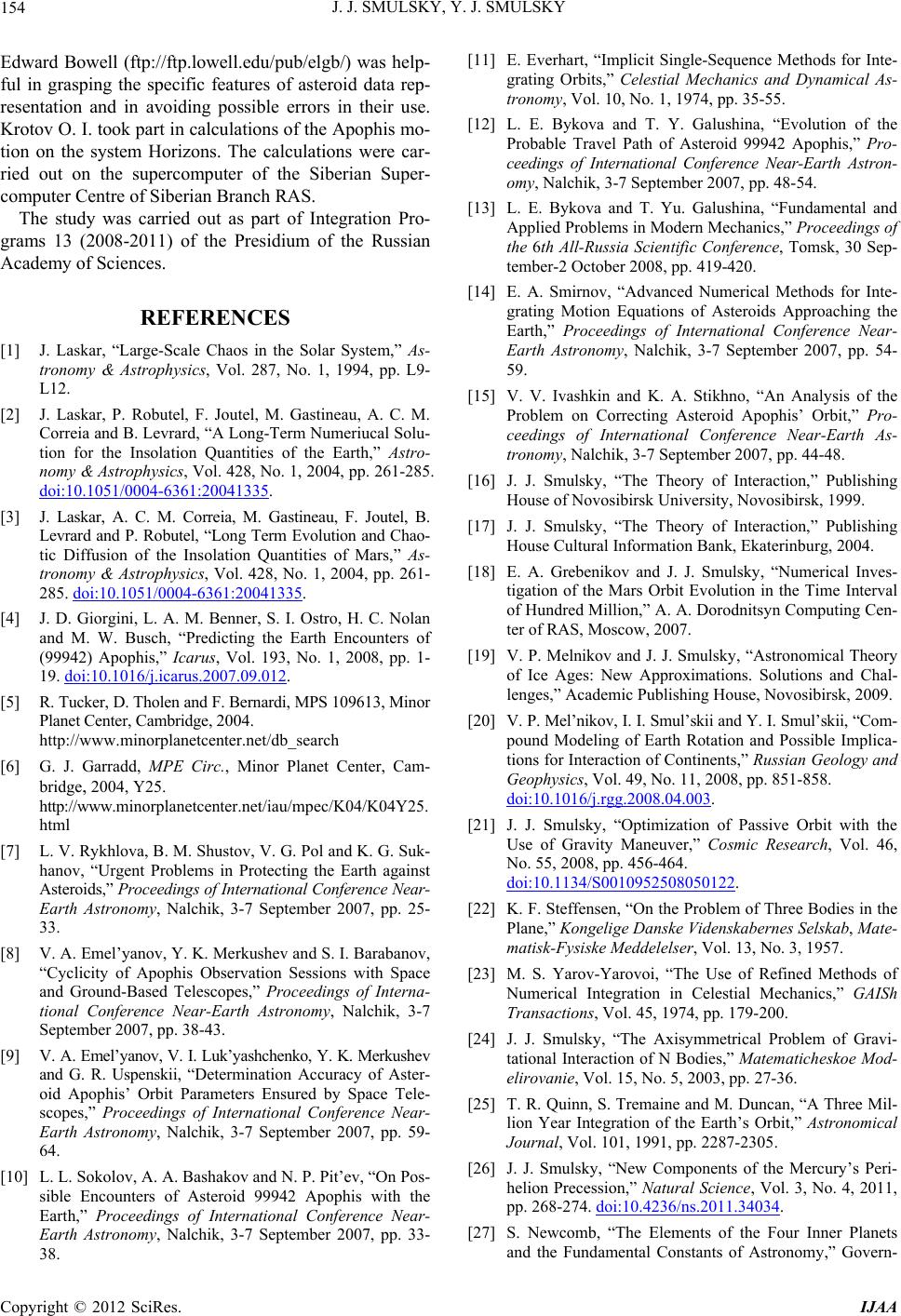 J. J. SMULSKY, Y. J. SMULSKY 154 Edward Bowell (ftp://ftp.lowell.edu/pub/elgb/) was help- ful in grasping the specific features of asteroid data rep- resentation and in avoiding possible errors in their use. Krotov O. I. took part in calculations of the Apophis mo- tion on the system Horizons. The calculations were car- ried out on the supercomputer of the Siberian Super- computer Centre of Siberian Branch RAS. The study was carried out as part of Integration Pro- grams 13 (2008-2011) of the Presidium of the Russian Academy of Sciences. REFERENCES [1] J. Laskar, “Large-Scale Chaos in the Solar System,” As- tronomy & Astrophysics, Vol. 287, No. 1, 1994, pp. L9- L12. [2] J. Laskar, P. Robutel, F. Joutel, M. Gastineau, A. C. M. Correia and B. Levrard, “A Long-Term Numeriucal Solu- tion for the Insolation Quantities of the Earth,” Astro- nomy & Astrophysics, Vol. 428, No. 1, 2004, pp. 261-285. doi:10.1051/0004-6361:20041335. [3] J. Laskar, A. C. M. Correia, M. Gastineau, F. Joutel, B. Levrard and P. Robutel, “Long Term Evolution and Chao- tic Diffusion of the Insolation Quantities of Mars,” As- tronomy & Astrophysics, Vol. 428, No. 1, 2004, pp. 261- 285. doi:10.1051/0004-6361:20041335. [4] J. D. Giorgini, L. A. M. Benner, S. I. Ostro, H. C. Nolan and M. W. Busch, “Predicting the Earth Encounters of (99942) Apophis,” Icarus, Vol. 193, No. 1, 2008, pp. 1- 19. doi:10.1016/j.icarus.2007.09.012. [5] R. Tucker, D. Tholen and F. Bernardi, MPS 109613, Minor Planet Center, Cambridge, 2004. http://www.minorplanetcenter.net/db_search [6] G. J. Garradd, MPE Circ., Minor Planet Center, Cam- bridge, 2004, Y25. http://www.minorplanetcenter.net/iau/mpec/K04/K04Y25. html [7] L. V. Rykhlova, B. M. Shustov, V. G. Pol and K. G. Suk- hanov, “Urgent Problems in Protecting the Earth against Asteroids,” Proceedings of International Conference Near- Earth Astronomy, Nalchik, 3-7 September 2007, pp. 25- 33. [8] V. A. Emel’yanov, Y. K. Merkushev and S. I. Barabanov, “Cyclicity of Apophis Observation Sessions with Space and Ground-Based Telescopes,” Proceedings of Interna- tional Conference Near-Earth Astronomy, Nalchik, 3-7 September 2007, pp. 38-43. [9] V. A. Emel’yanov, V. I. Luk’yashchenko, Y. K. Merkushev and G. R. Uspenskii, “Determination Accuracy of Aster- oid Apophis’ Orbit Parameters Ensured by Space Tele- scopes,” Proceedings of International Conference Near- Earth Astronomy, Nalchik, 3-7 September 2007, pp. 59- 64. [10] L. L. Sokolov, A. A. Bashakov and N. P. Pit’ev, “On Pos- sible Encounters of Asteroid 99942 Apophis with the Earth,” Proceedings of International Conference Near- Earth Astronomy, Nalchik, 3-7 September 2007, pp. 33- 38. [11] E. Everhart, “Implicit Single-Sequence Methods for Inte- grating Orbits,” Celestial Mechanics and Dynamical As- tronomy, Vol. 10, No. 1, 1974, pp. 35-55. [12] L. E. Bykova and T. Y. Galushina, “Evolution of the Probable Travel Path of Asteroid 99942 Apophis,” Pro- ceedings of International Conference Near-Earth Astron- omy, Nalchik, 3-7 September 2007, pp. 48-54. [13] L. E. Bykova and T. Yu. Galushina, “Fundamental and Applied Problems in Modern Mechanics,” Proceedings of the 6th All-Russia Scientific Conference, Tomsk, 30 Sep- tember-2 October 2008, pp. 419-420. [14] E. A. Smirnov, “Advanced Numerical Methods for Inte- grating Motion Equations of Asteroids Approaching the Earth,” Proceedings of International Conference Near- Earth Astronomy, Nalchik, 3-7 September 2007, pp. 54- 59. [15] V. V. Ivashkin and K. A. Stikhno, “An Analysis of the Problem on Correcting Asteroid Apophis’ Orbit,” Pro- ceedings of International Conference Near-Earth As- tronomy, Nalchik, 3-7 September 2007, pp. 44-48. [16] J. J. Smulsky, “The Theory of Interaction,” Publishing House of Novosibirsk University, Novosibirsk, 1999. [17] J. J. Smulsky, “The Theory of Interaction,” Publishing House Cultural Information Bank, Ekaterinburg, 2004. [18] E. A. Grebenikov and J. J. Smulsky, “Numerical Inves- tigation of the Mars Orbit Evolution in the Time Interval of Hundred Million,” A. A. Dorodnitsyn Computing Cen- ter of RAS, Moscow, 2007. [19] V. P. Melnikov and J. J. Smulsky, “Astronomical Theory of Ice Ages: New Approximations. Solutions and Chal- lenges,” Academic Publishing House, Novosibirsk, 2009. [20] V. P. Mel’nikov, I. I. Smul’skii and Y. I. Smul’skii, “Com- pound Modeling of Earth Rotation and Possible Implica- tions for Interaction of Continents,” Russian Geology and Geophysics, Vol. 49, No. 11, 2008, pp. 851-858. doi:10.1016/j.rgg.2008.04.003. [21] J. J. Smulsky, “Optimization of Passive Orbit with the Use of Gravity Maneuver,” Cosmic Research, Vol. 46, No. 55, 2008, pp. 456-464. doi:10.1134/S0010952508050122. [22] K. F. Steffensen, “On the Problem of Three Bodies in the Plane,” Kongelige Danske Videnskabernes Selskab, Mate- matisk-Fysiske Meddelelser, Vol. 13, No. 3, 1957. [23] M. S. Yarov-Yarovoi, “The Use of Refined Methods of Numerical Integration in Celestial Mechanics,” GAISh Transactions, Vol. 45, 1974, pp. 179-200. [24] J. J. Smulsky, “The Axisymmetrical Problem of Gravi- tational Interaction of N Bodies,” Matematicheskoe Mod- elirovanie, Vol. 15, No. 5, 2003, pp. 27-36. [25] T. R. Quinn, S. Tremaine and M. Duncan, “A Three Mil- lion Year Integration of the Earth’s Orbit,” Astronomical Journal, Vol. 101, 1991, pp. 2287-2305. [26] J. J. Smulsky, “New Components of the Mercury’s Peri- helion Precession,” Natural Science, Vol. 3, No. 4, 2011, pp. 268-274. doi:10.4236/ns.2011.34034. [27] S. Newcomb, “The Elements of the Four Inner Planets and the Fundamental Constants of Astronomy,” Govern- Copyright © 2012 SciRes. IJAA 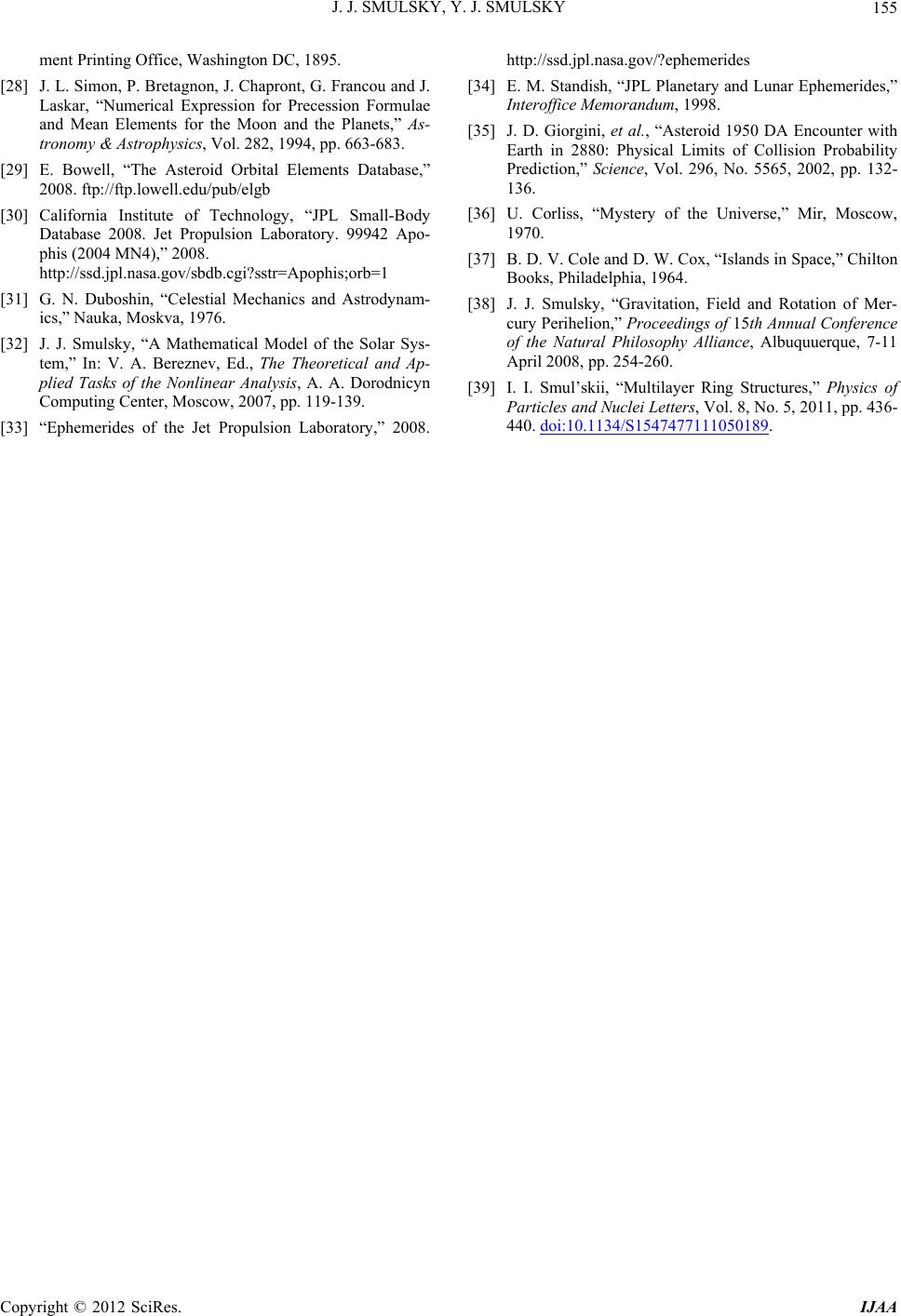 J. J. SMULSKY, Y. J. SMULSKY Copyright © 2012 SciRes. IJAA 155 ment Printing Office, Washington DC, 1895. [28] J. L. Simon, P. Bretagnon, J. Chapront, G. Francou and J. Laskar, “Numerical Expression for Precession Formulae and Mean Elements for the Moon and the Planets,” As- tronomy & Astrophysics, Vol. 282, 1994, pp. 663-683. [29] E. Bowell, “The Asteroid Orbital Elements Database,” 2008. ftp://ftp.lowell.edu/pub/elgb [30] California Institute of Technology, “JPL Small-Body Database 2008. Jet Propulsion Laboratory. 99942 Apo- phis (2004 MN4),” 2008. http://ssd.jpl.nasa.gov/sbdb.cgi?sstr=Apophis;orb=1 [31] G. N. Duboshin, “Celestial Mechanics and Astrodynam- ics,” Nauka, Moskva, 1976. [32] J. J. Smulsky, “A Mathematical Model of the Solar Sys- tem,” In: V. A. Bereznev, Ed., The Theoretical and Ap- plied Tasks of the Nonlinear Analysis, A. A. Dorodnicyn Computing Center, Moscow, 2007, pp. 119-139. [33] “Ephemerides of the Jet Propulsion Laboratory,” 2008. http://ssd.jpl.nasa.gov/?ephemerides [34] E. M. Standish, “JPL Planetary and Lunar Ephemerides,” Interoffice Memorandum, 1998. [35] J. D. Giorgini, et al., “Asteroid 1950 DA Encounter with Earth in 2880: Physical Limits of Collision Probability Prediction,” Science, Vol. 296, No. 5565, 2002, pp. 132- 136. [36] U. Corliss, “Mystery of the Universe,” Mir, Moscow, 1970. [37] B. D. V. Cole and D. W. Cox, “Islands in Space,” Chilton Books, Philadelphia, 1964. [38] J. J. Smulsky, “Gravitation, Field and Rotation of Mer- cury Perihelion,” Proceedings of 15th Annual Conference of the Natural Philosophy Alliance, Albuquuerque, 7-11 April 2008, pp. 254-260. [39] I. I. Smul’skii, “Multilayer Ring Structures,” Physics of Particles and Nuclei Letters, Vol. 8, No. 5, 2011, pp. 436- 440. doi:10.1134/S1547477111050189.
|